Abstract
Reconstructing ancient tectonic environments is inherently difficult and requires the integration of many datasets. Here we attempt to reconstruct the tectonic setting of a Proterozoic magmatic rock suite from the Archean to Mesoproterozoic Gawler Craton, South Australia. We evaluate previous models of subduction or non-subduction tectonics for the St Peter Suite through field observations coupled with geochemical and isotopic data. Field observations indicate the presence of mafic magma chambers, felsic plutons and zones of mixing represented by multiphase plutons and zones of magma transfer. Syn-magmatic and solid-state deformation fabrics suggest magmatism was associated with a compressional tectonic regime, at least during some stages of magmatism. Zircon U–Pb geochronology suggests magmatism occurred between ca 1633 and ca 1608 Ma, an interval of ca 25 Myr. Mafic rocks are tholeiitic and enrichment in high field strength and light rare earth elements supports a modified mantle source region. Mafic rocks have εNd1620 Ma values around 0, and zircon εHf(t) values around 4, supporting minor crustal contamination. Felsic plutons have a geochemical signature similar to average continental crust, εNd1620 Ma between –3.7 and 0.4, and zircon Lu–Hf isotopic compositions that yield to εHf(t) values between –1.8 and 7.7, suggesting they were derived from fractionation of enriched tholeiitic parent magmas. A model for the formation of the St Peter Suite that is most consistent with the available data is one that places the magmatism in a broadly continental magmatic arc setting, albeit one in which little or no Archean crust was involved. Potentially this magmatic arc could have been built on a thinned, or hyper-extended continental margin. The integration of structural, geochemical and isotopic constraints has provided a more holistic view of the St Peter Suite petrogenesis than previously available.
Evaluation of models of subduction vs non-subduction tectonics for formation of Paleoproterozoic magmatic suite
Evidence for syn-magmatic compression and mafic–felsic magma mingling
Isotopically juvenile (Nd--Sr--Hf) with mantle-like zircon δ18O values
Continental arc setting proposed, possibly on hyper-extended continental margin
Highlights
Introduction
Interpretation for the tectonic setting for Proterozoic magmatism of the Australian continent has generally fallen into one of two end-member schools of thought; those that appeal to subduction processes and those that do not. At one end of this spectrum are models that advocate an essentially modern, Phanerozoic-like plate tectonic regime. In these models, subduction zones are interpreted to have been present between major building blocks of the Australian continent. Closure of these subduction zones by continental collision is interpreted to have caused amalgamation of the continent at various times during the Proterozoic (e.g. Betts & Giles, Citation2006; Cawood & Korsch, Citation2008; Giles, Betts, & Lister, Citation2004; Myers, Shaw, & Tyler, Citation1996). In some models, subduction zones are inferred to have existed internal to some of the major building blocks of Australia, for example amalgamation of the Aileron Province with the Davenport Province/Tanami Region across the Willowra Suture (Aitken et al., Citation2016; Betts et al., Citation2016; Betts, Giles, & Aitken, Citation2011). The implication is that the continent can be viewed as a series of ribbons or micro-continents that have been accreted in a style of tectonics that is reminiscent of the tectonic ‘collage’ that makes up central Asia (cf. Şengör, Altıner, Cin, Ustaömer, & Hsü, Citation1988).
A difficulty with models that advocate modern-style tectonics has been the general paucity of magmatic suites that the geochemical community has been confident to classify as being subduction- or arc-related. As a result, alternative models have been produced that favour an intracontinental setting for the generation of bimodal magmatic suites via mafic underplating in the absence of contemporary subduction zone interaction (Wyborn, Page, & Parker, Citation1987; Wyborn, Wyborn, Warren, & Drummond, Citation1992). In such models, the melting of continental lithospheric mantle is interpreted to be a result of decompression related to continental-scale extension, rather than being influenced by fluids derived from a subducting slab. Indeed, it is the case that many Australian Proterozoic magmatic suites are broadly bimodal in SiO2 composition in which the granites are Sr-depleted, and Y-undepleted, indicating derivation within the plagioclase stability field (Wyborn et al., Citation1992). These features generally contrast with subduction zone magmatism that typically produces an abundance of intermediate, andesitic compositions (Ducea, Saleeby, & Bergantz, Citation2015). In addition, Proterozoic magmatic suites are typically relatively reduced, dominated by ilmenite rather than magnetite (Budd, Wyborn, & Bastrakova, Citation2001), which is another point of difference between these magmatic suites and those more oxidised, calc-alkaline magmas formed in modern subduction-related systems (Wyborn et al., Citation1992).
The St Peter Suite of the Gawler Craton has been cited as an example of subduction-related magmatism within the Proterozoic of Australia (e.g. Korsch, Kositcin, & Champion, Citation2011) with the interpreted subduction process considered to have had a significant impact on the overall geodynamic and metallogenic evolution of the Gawler Craton (Skirrow, Wielen, Champion, Czarnota, & Thiel, Citation2018). However, the only published geochemical study completed on the St Peter Suite focused largely on apparent depletions in Nb, Ta and Ti, and enrichment in large-ion lithophile elements (LILEs) evident in whole-rock geochemistry and the relatively juvenile Sm–Nd isotopic signature of the suite to interpret derivation above a contemporaneous intra-oceanic subduction zone (Swain, Barovich, Hand, Ferris, & Schwarz, Citation2008). While depletions in Nb, Ta and Ti are a feature of subduction zone magmatic rocks, it is important to recognise that depletions such as these are characteristic of the vast majority of continental magmatic rocks and juvenile isotopic compositions are not unique to subduction systems (e.g. Rudnick & Gao, Citation2003). Therefore, while many studies have relied upon the original study of Swain et al. (Citation2008) as validation of the presence of direct subduction zone magmatism within the Proterozoic of Australia, there remains doubt as to if this interpretation is correct, or indeed the only possible model for the petrogenesis of the St Peter Suite.
The purpose of this contribution is to test the two different end-member models—subduction or extension in the absence of subduction—for the formation of the Paleoproterozoic St Peter Suite of the Gawler Craton. We examine these models based on new field observations from the excellent coastal exposures of the St Peter Suite, coupled with new U–Pb geochronology, whole-rock geochemistry, Sm–Nd–Sr and zircon Lu–Hf–O isotopic data.
Geological setting
The St Peter Suite is located in the southwestern portion of the Gawler Craton, forming the bulk of the region known as the Nyuts Domain (; Daly, Fanning, & Fairclough, Citation1998; Ferris, Schwarz, & Heithersay, Citation2002; Hand, Reid, & Jagodzinski, Citation2007; Reid, Citation2017). The Gawler Craton is an Archean to Mesoproterozoic continental domain that makes up a region in southern Australia over 380 000 km2. The Gawler Craton comprises an Archean to earliest Paleoproterozoic basement that includes ca 3150 Ma (Cooyerdoo Granite) and ca 2555–2410 Ma granites, gneisses and supracrustal sequences deformed and metamorphosed during an earliest Paleoproterozoic orogenic event (Sleafordian Orogeny; Daly & Fanning, Citation1993; Fraser, McAvaney, Neumann, Szpunar, & Reid, Citation2010; Reid, Jagodzinski, Fraser, & Pawley, Citation2014). Extensive Paleoproterozoic volcano-sedimentary successions were deposited onto this basement across much of the northern, eastern and southern Gawler Craton before being deformed and metamorphosed during a widespread ca 1730–1690 Ma tectonometamorphic event (Kimban Orogeny; Hand et al., Citation2007). Late in this event, a series of moderately juvenile magmatic rocks were emplaced in an belt across the central Gawler Craton (Tunkillia Suite; Payne, Ferris, Barovich, & Hand, Citation2010).
Figure 1. Interpreted crystalline basement map of the Gawler Craton showing the location of the St Peter Suite. Inset shows the location of the Gawler Craton within Australia and some of the major Archean–Proterozoic terranes of Australia.
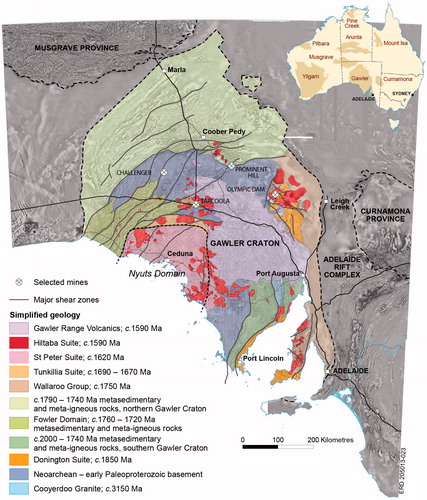
Subsequent to the Kimban Orogeny, the transition from the Paleo- to Mesoproterozoic is recorded by the formation of sedimentary basins in the central Gawler Craton, preserved in the fault-bound complex of sedimentary rocks and minor intercalated mafic–felsic volcanics of the ca 1650 Ma Tarcoola Formation (; Daly et al., Citation1998). After this volcano-sedimentary episode, the dominant geological process of the Gawler Craton was magmatism, as manifest in the ca 1633–1608 Ma St Peter Suite and the early Mesoproterozoic Gawler Range Volcanics and Hiltaba Suite (Flint et al., Citation1993; Flint, Rankin, & Fanning, Citation1990). The St Peter Suite, together with volumetrically minor associated volcanics and porphyritic intrusives of the Nyuts Volcanics, occur in the southwestern portion of the Gawler Craton ( and ) and are reviewed in more detail below. The Gawler Range Volcanics and Hiltaba Suite represent a ca 1595–1575 Ma silicic large igneous province (Allen, McPhie, Ferris, & Simpson, Citation2008; Flint et al., Citation1993). This early Mesoproterozoic magmatic event was highly significant for the overall evolution of the Gawler Craton, being associated with widespread deformation, fluid flow and mineralisation including deposits of the iron oxide–copper–gold type such as Olympic Dam (Daly et al., Citation1998; Hand et al., Citation2007; Skirrow et al., Citation2007). Reactivation of major shear zones and localised deformation occurred at ca 1450 Ma (Fraser & Lyons, Citation2006; Fraser, Reid, & Stern, Citation2012), and the Gawler Craton was subsequently variably buried by Neoproterozoic, Paleozoic, Mesozoic and Cenozoic sedimentary successions including Paleogene sediments of the Eucla Basin, and eolian dune fields formed during the Plio-Pleistocene (e.g. Hou et al., Citation2011).
Figure 2. Surface geology and potential field data across the region of the St Peter Suite, central Gawler Craton. Also shown are the location of U–Pb geochronology samples of St Peter Suite age from this and previous studies along with the orientation of solid-state deformation fabrics within the St Peter Suite. (a) Surface geology map of the southern portion of the St Peter Suite showing the location of coastal exposures. (b) Reduced to pole total magnetic intensity image. (c) Bouguer gravity image. Geological Survey of South Australia data available via SARIG, https://map.sarig.sa.gov.au/. Geochronology data from this study, Fanning et al. (Citation2007), Symington et al. (Citation2014) and Reid and Dutch (Citation2012). Structural fabric data from this study, Pawley et al. (Citation2016) and Symington et al. (Citation2014).
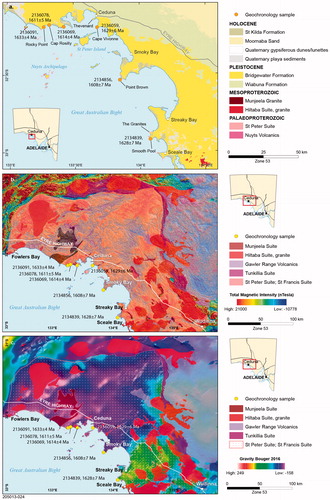
St Peter Suite
The St Peter Suite can be interpreted based on outcrop and potential field geophysical data to occupy a broad domain of up to 25 000 km2 in the central-western Gawler Craton (). The suite is largely buried beneath a thin veneer of Cenozoic sedimentary cover, with the most continuous outcrop occurring along the west coast of the Eyre Peninsula and near shore islands (). The St Peter Suite appears to be predominantly bound by shear zones (; e.g. Stewart & Betts, Citation2010). There are no known contact relationships exposed between the St Peter Suite and older basement for the Gawler Craton.
The St Peter Suite comprises a variety of lithotypes ranging in composition from quartz monzonite, granite, granodiorite, tonalite and diorite to gabbro and pyroxenite (Flint et al., Citation1990). Felsic lithologies are generally enriched in LILEs (e.g. Rb, K, Ba) and depleted in high-field-strength elements (e.g. Ta, Nb, Ti; Flint et al., Citation1990; Swain et al., Citation2008). Mafic rock types such as gabbro and pyroxenite may have potential for Ni–Cu sulfide mineralisation (Flint et al., Citation1990). The St Peter Suite is isotopically juvenile with respect to the typical Archean–Paleoproterozoic crust of the Gawler Craton recorded in both the Sm–Nd and zircon Lu–Hf isotopic systems (Reid & Payne, Citation2017; Swain et al., Citation2008). The St Peter Suite preserves evidence for deformation during its emplacement with generally north–south-trending solid-state fabrics (Flint et al., Citation1990; Symington et al., Citation2014).
Associated with the St Peter Suite are the Nuyts Volcanics and the St Francis Granite, which are exposed only on islands of the Nuyts Archipelago (). The Nuyts Volcanics have been dated at 1631 ± 3 Ma and 1627 ± 2 Ma (Cooper, Mortimer, Rosier, & Uppill, Citation1985; Rankin, Flint, & Fanning, Citation1990), indicating they are co-eval with the St Peter Suite. The Nuyts Volcanics comprise porphyritic rhyodacite and rhyolite that preserve quartz and feldspar phenocrysts in a fine-grained matrix, with local examples of flow banding and lapilli (Rankin et al., Citation1990). These porphyritic rocks are intruded by rhyodacite to rhyolite dykes and a distinctive leucogranite, the latter of which is termed the St Francis Granite. These porphyritic volcanics preserve a foliation defined by fine-grained mica growth that is steeply dipping and north–south oriented (Flint & Rankin, Citation1991; Rankin & Flint, Citation1989).
Total magnetic intensity data reveal the inland extent of the St Peter Suite away from the coastal exposures (). The moderate magnetic response of the St Peter Suite is correlated with a region of low gravity response (). Magnetotelluric data suggest the St Peter Suite lies above a very resistive lower crust and continental mantle (Thiel & Heinson, Citation2010, Citation2013). By correlation with the geophysical properties of the Neoarchean rocks in the Gawler Craton, the St Peter Suite is inferred to overlie Archean lower crust (Motta et al., Citation2019; Thiel & Heinson, Citation2013).
Methods
Reconnaissance field mapping was undertaken across the coastal exposures of the St Peter Suite. A focus of the mapping was to understand the physical magma processes and to document the structural geometry of the St Peter Suite. Structural measurements on magmatic and solid-state structural elements were taken. Sampling for geochemical and isotopic analysis was based on certainty of comagmatism between, for example, mafic rocks and associated felsic rocks. Therefore, these field observations provided the context for the diversity of lithologies and compositional range of the St Peter Suite.
Analytical methods employed on the samples are detailed in the Supplementary papers (Appendix 1) and summarised briefly as follows. SHRIMP U–Pb zircon geochronology was undertaken at Geoscience Australia, Canberra, using a SHRIMP IIe instrument. Zircon analyses were undertaken on mineral separates mounted in epoxy discs along with relevant standard grains and imaged via transmitted light, backscatter electron and cathodoluminescence (CL) techniques. Zircon Lu–Hf isotopic measurements were conducted by laser ablation multi-collector inductively coupled plasma mass spectroscopy (LA-MC-ICPMS) using a Neptune MC-ICPMS coupled with a 193 nm ArF Excimer laser at the Australian National University, Canberra, using similar procedures to Munizaga et al. (Citation2008). Zircon oxygen isotope ratios were determined at the Australian National University, Canberra, using SHRIMP II instrumentation fitted with a Cs source and electron gun for charge compensation following methods described by Ickert et al. (Citation2008). The Temora II reference zircon was analysed to monitor and correct for isotope fractionation. Lu–Hf and oxygen isotope analyses were performed on the same locations within single zircon grains as used for U–Pb isotope analyses. Whole-rock major- and trace-element geochemistry was undertaken at a commercial laboratory, ALS Global, Perth (http://www.alsglobal.com/minerals.aspx). The Sm–Nd–Sr isotopic composition of whole-rock samples was determined at the University of Adelaide using methods similar to those reported by Wade, Hand, and Barovich (Citation2005) and Wade, Payne, Barovich and Reid (Citation2019).
Field relationships of magmatic rocks of the St Peter Suite
Physical magma processes
Features of the physical magma processes important for the formation of the St Peter Suite evident at outcrop scale have been described by previous workers (e.g. Flint et al., Citation1990; Pawley, Reid, & Dutch, Citation2016; Symington et al., Citation2014) and here we present a summary of our field observations, with reference to this previous work. The St Peter Suite comprises both felsic bodies and mafic bodies and zones of magma transfer in which magmas of both felsic and mafic composition have interacted, mingled and partially hybridised (Pawley et al., Citation2016). Felsic magma chambers are evident as medium- to coarse-grained, equigranular to porphyritic granite to granodiorite bodies (). These rocks are generally massive, but locally contain a magmatic foliation defined by aligned subhedral phenocrysts and mafic schlieren (). Mafic magma bodies are present, although at least in the exposed portions of the St Peter Suite, are subordinate in volume to the felsic bodies. The best example of a St Peter Suite mafic magma chamber occurs at Cap Rosilly (), where there are coarse-grained equigranular gabbro, inequigranular quartz diorite and pyroxenite. Massive gabbro and quartz diorite include zones where ovoid aggregations of mesocratic, quartz-poor diorite form pillow-like structures within a more leucocratic, quartz diorite groundmass in textures that suggest mingling of a more mafic magma with a quartz-bearing magma of possibly hybrid composition (). There are also examples of angular blocks of massive diorite within in a groundmass of massive tonalite (). This texture suggests that some of the mafic magma was semi-solid and able to fracture when the felsic magma was injected, forming a magmatic breccia. Pyroxenite layers at the Cap Rosilly locality have cumulate textures and locally developed cross-beds and scours within the cumulate zones resulting from flow within the magma chamber ().
Figure 3. Physical magmatic features of the St Peter Suite. (a) Detail of typical medium-grained, equigranular granite texture within felsic magma chamber, near Ceduna. (b) Detail of typical medium-grained, equigranular granite texture with mafic schlieren, Point James. Mafic body of the St Peter Suite, Cap Rosilly. (c) Quartz-poor diorite form pillow-like structures within a more leucocratic quartz diorite groundmass, Cap Rosilly. (d) Magmatic breccia body, Cap Rosilly, in which diorite body is brecciated by granite phase. (e) Mineral cross bedding within pyroxenite layer, Cap Rosilly. (f) Mafic dyke intruding granitoid showing lobate contacts with the host granitoid and zones of mingling and likely hybridisation between felsic and mafic compositions within the mafic dyke mafic itself. Point Brown locality. (g) Monzogranite intruded by basaltic sheet that locally has irregular, lobate contacts with the granite and thin irregular apophysis. Point James locality. (h) Contact zone between weakly foliated granite host and grey, medium-grained, biotite-rich phase that is likely a product of hybridisation between mafic and felsic magmas. This intermediate rock generally has gradational and lobate contacts with the granodiorite.
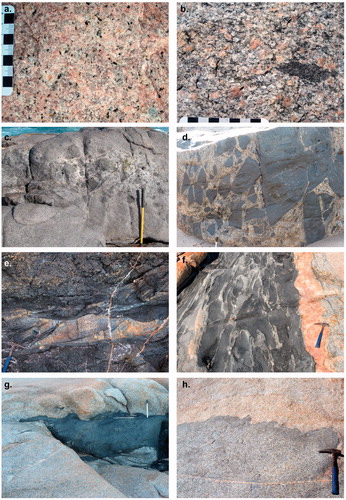
The St Peter Suite contains examples of co-mingling of mafic and felsic magmas within multiphase plutons. The presence of mafic enclaves within granite and mafic dykes with lobate contacts with the host granitoid suggest intrusion of syn-plutonic mafic dykes (). These intrusions range from relatively homogeneous very fine-grained basalt () to grey, medium-grained, feldspar-rich phases (), suggesting variable degrees of hybridisation between mafic and felsic magmas either at lower crustal levels, or during magma ascent.
Evidence for syn-magmatic deformation
The presence of structural elements including deformation fabrics, folding, and melt-filled shear fabrics attest to the fact that magmatism of the St Peter Suite was accompanied by some degree of strain (see also Stewart & Betts, Citation2010; Symington et al., Citation2014). Alignment of elongate euhedral to subhedral minerals, mafic schlieren, elongate mafic enclaves are the most prominent evidence for deformation and at some localities, such foliations are parallel to an igneous layering, defined by compositional and textural variation in the granitic to intermediate rocks. For example at the Smooth Pool locality (), monzogranite sheets with a solid-state deformation fabric defined by quartz ribbons are cut by sheets of granodiorite, which themselves contain biotite lenses that define a magmatic flow foliation aligned sub-parallel to the solid-state foliation in the monzogranite (). The granodiorites and monzogranites may also contain mafic enclaves that are elongate parallel to the magmatic foliation (). These zones likely represent conduits in which contemporaneous mafic and felsic magmas flowed and mingled. The concordance of the solid-state and magmatic flow foliations suggests strain started while the rocks were still magmatic and continued until after they had crystallised. The deformation fabrics and compositional layering across the coastal outcrops of the St Peter Suite are generally north-striking and steeply dipping (). The exception to this consistent strike direction with the exception of two sites (i.e. The Granites and Cap Rosilly, where the foliations and layering are north-northwest-striking; ).
Figure 4. Structural elements indicating St Peter Suite was accompanied by deformation. (a) Pale-blue to grey monzogranite, with locally developed north-striking schlieric layering and a parallel, moderately developed solid-state foliation. The monzogranite is interlayered with a medium- to coarse-grained, pale-pink to cream coloured granite that contains small wispy biotite lenses (<1 mm-wide and 1 cm long), which define a magmatic-state foliation aligned parallel to the layering and foliation in the monzogranite. Immediately to the left of the hammer is a granite sheet that has a pinch and swell geometry. View to the north, with the hammer head pointing to the north. (b) Elongate mafic enclaves within granodiorite that are elongate parallel to the magmatic foliation. Also note the granite sheet at right of field of view that cuts the earlier magmatic phases. Smooth Pool locality. (c) Folding within granodiorite sheets at the Smooth Pool locality. View to the south, down plunge of isoclinal fold. (d) Leucogranite-filled shear bands within boudinaged mafic sheet. Geometry of the shear bands indicate sinistral sense of shear. Thevenard locality. (e) Example of a solid-state foliation developed within mafic-poor granite at the Thevenard locality. The foliation is defined by elongate quartz aggregates and strikes north–south at this location. Plan view with the black pen cap pointing to the north. (f) Example of magmatic-state C–S planes from The Granites locality. (g) Magmatic-state foliation (defined by common biotite lamellae) within coarse-grained, feldspar porphyritic monzogranite, together with a parallel leucogranite sheet is offset by an apparently sinistral shear zone. Point Brown locality. (h) Example of more gneissic-type granitoid of the St Peter Suite from Rocky Point locality. The field of view shows the contact between a granite sheet on the left-hand side that lies parallel to the main biotite-defined foliation within a biotite-rich gneiss.
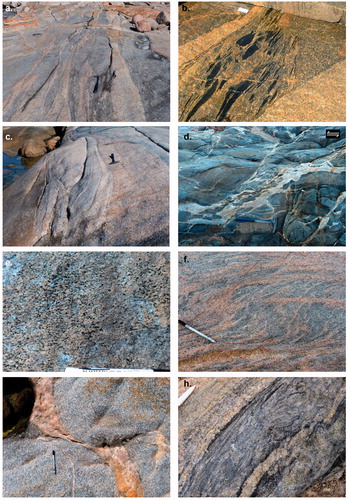
Figure 5. Stereonet showing the orientations of the magmatic- and solid-state structures recognised in the coastal outcrops of the St Peter Suite. Magmatic foliation refers to a magmatic-state foliation, which is generally defined by alignment of elongate euhedral to subhedral minerals, mafic schlieren, elongate mafic enclaves. At some sites, e.g. Smooth Pool, these foliations are parallel to an igneous layering, defined by compositional and textural variation in the granitic to intermediate rocks. Note that the two measurements that show north-northwest-strike are from The Granites and Cap Rosilly localities. There are two types of shear foliations, a set of right-lateral and a set of left-lateral shear zones. Both are predominantly strike-slip. These shear zones are melt-filled, indicating they formed while the magma was crystallising with late-stage, residual melt migrating into the dilational zones. Lineations were not observed in these shear zones. Also plotted are the solid-state foliations, which are generally represented by elongate recrystallised quartz aggregates, indicating deformation occurred subsequent to magmatic crystallisation.
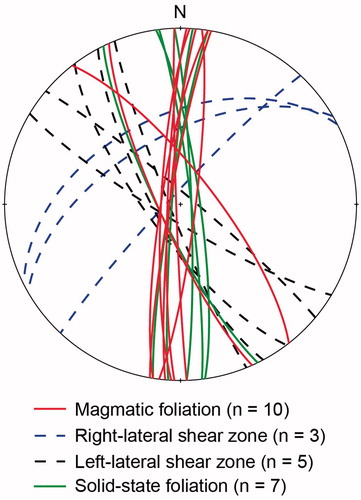
Folding of magmatic fabrics is also evident within the St Peter Suite. Good examples occur at the Smooth Pool locality (), where interlayered monzogranite and granodiorite are folded into asymmetrical, isoclinal folds approximately 1.5 m in amplitude (). These folds generally have a sub-horizontal to shallow south plunge and an axial plane that is sub-parallel to the main trend of the compositional layering. The orientation of the axial planar foliation suggests it formed under east–west shortening (current orientation). The magmatic foliation is aligned parallel to the axial plane of the fold, suggesting folding occurred during crystallisation of the magmatic sheets.
Melt-filled shear bands are present in some of the magma transfer zones. Good examples of this occur in coastal outcrops near the town of Ceduna, where interlayered north-striking granitic to dioritic sheets are cut by both northwest-striking, apparently sinistral, leucogranite-filled shear bands (). Mineral lineations were not observed at these outcrops, so it is unclear whether shearing is purely strike-slip or if there is also a down-dip component. This locality also has a set of northeast-striking apparently dextral shear bands, which are likewise filled with leucogranite indicating there is a conjugate set of these deformation zones. There is also a well-developed north-striking solid-state foliation defined by biotite and elongate quartz aggregates (), suggesting that the strain continued from the magmatic to solid state as the rocks crystallised.
Magmatic-state C–S planes are also present. An example from the locality known as ‘The Granites’ shows thin (<1 cm wide) leucogranite veins with irregular gradational margins within granodiorite, suggesting they formed late in the crystallisation history. These veins are commonly aligned parallel to the foliation, giving the rock a gneissic appearance, but in some places the veins are sigmoidal and oblique to the trend of the foliation, forming features that are analogous to mica fish and C–S planes in mylonites (). These features generally suggest an apparent sinistral sense of shear, but dextral is also present. It is possible that the leucogranite veins represent late-stage residual magma that was remobilised during shearing, migrating into lower pressure sites such as the S planes. This would indicate that shearing, and the development of the foliation and other structural elements at The Granites was syn-magmatic. The field relations at The Granites suggest that the foliation and leucogranite veins in the granodiorite formed under the same stress field into which the larger, 1–2 m-wide granite sheets were intruded. Based on the presence of both apparent sinistral and dextral kinematic indicators, this is interpreted to have been under east-northeast–west-southwest-directed shortening. There are also examples of shear bands and zones of high strain that deform the pre-existing magmatic fabric ().
The transition from sheeted igneous rocks, through the melt-filled shear bands and boudins, to the solid-state foliation, suggests that the stresses were present during the emplacement of the St Peter Suite, likely representing a magma transfer zone (indicated by the compositional and textural variation in this area), and continued as the magmas crystallised. The inference of east–west-directed shear during emplacement is consistent with observations made at the Yarlbrinda Hill locality in the northeastern portion of the St Peter Suite, where a 1622 ± 6 Ma St Peter Suite granite contains a north-northwest-striking mylonitic fabric defined by quartz ribbons that is cut by similarly oriented zones of cataclasite and pseudotachylite (Fanning, Reid, & Teale, Citation2007; Stewart & Betts, Citation2010).
The St Peter Suite also contains gneissic and locally migmatitic units (), particularly in the region of Rocky Point as described by Symington et al. (Citation2014). In this region, the St Peter Suite is characterised by tonalitic intrusions that contain mafic dykes and enclaves, along with zones of pink leucogranite and biotite monzogranite. This portion of the St Peter Suite also contains evidence for local partial melting during deformation in the form of leucosomes oriented parallel to fold axial planes. Symington et al. (Citation2014) dated early tonalitic migmatitic gneisses to have a magmatic crystallisation age of 1647 ± 12 Ma, and a leucosome phase to have crystallised at 1605 ± 7 Ma. Symington et al. (Citation2014) interpreted this to indicate that early units of the St Peter Suite were remelted and deformed during emplacement of later phases of the St Peter Suite within one tectono-magmatic event. In addition, both magmatic and deformation foliations within the gneissic rocks at the Rocky Point locality strike approximately east–west and are associated with shear zones that record both sinistral and lesser dextral kinematics (Symington et al., Citation2014).
Geochemical and isotopic analytical results
Geochronology results are summarised in . All isotopic and geochemical data are fully tabulated in the Supplementary papers (Appendix 2).
Table 1. Summary of SHRIMP zircon U–Pb geochronology and Lu–Hf, O and Sm-Nd isotopic data from samples of the St Peter Suite obtained during this study.
SHRIMP zircon U–Pb geochronology
Six samples were selected for SHRIMP zircon geochronology (; locations shown on ). Full analytical details are given in a Geological Survey of South Australia technical report (Reid, Pawley, Jagodzinski, & Dutch, Citation2016) and all data are given in Supplementary papers (Table S1). Details of these samples and the SHRIMP geochronology is given here in summary form as a companion to Hf and O isotope data presented here. The samples are described in order of age, from oldest to youngest.
Sample 2136091 is a biotite--monzogranite from Rocky Point. Zircons from the sample are 100–150 μm in length and are predominantly euhedral, exhibit fine-scale oscillatory zoning under CL and interpreted to be a single igneous zircon population (). Twenty-six grains were analysed (), with 25 grains yielding a weighted mean 207Pb/206Pb age of 1633 ± 4 Ma (MSWD = 1.4; Pequiv = 0.095). A single analysis yields an age of 1711 ± 9 Ma (1σ; 6091.3.1), interpreted to be inherited within the monzogranite.
Figure 6. Representative zircon CL images for samples analysed in this study. (a) Sample 2136091. (b) Sample 2136059. (c) Sample 2134839. (d) Sample 2136069. (e) Sample 2136078. (f) Sample 2134856.
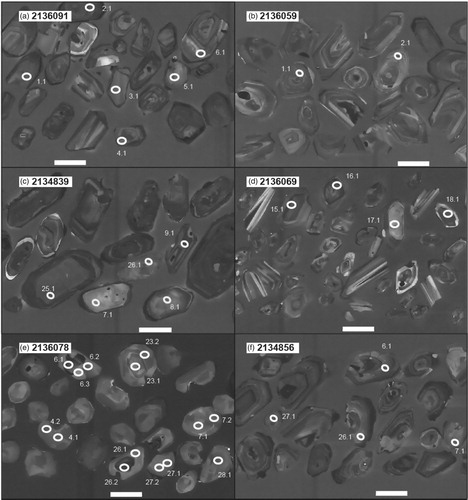
Figure 7. Tera-Wasserburg concordia diagrams for samples analysed in this study. (a) Sample 2136091. (b) Sample 2136059. (c) Sample 2134839. (d) Sample 2136069. (e) Sample 2136078. (f) Sample 2134856.
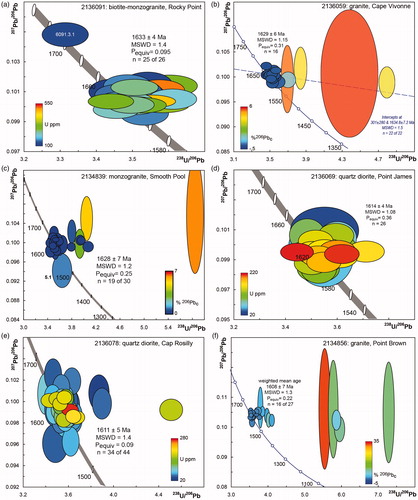
Sample 2136059 is a granite from Cape Vivonne. Zircons from the sample range in size from 100–200 μm, are euhedral, with pyramidal terminations, are clear and exhibit oscillatory zoning under CL (). Twenty-two grains were analysed, with some discordance and high common Pb indicated in the data set. Eliminating the five most discordant analyses and a single slightly older analyses (3.1) a weighted mean 207Pb/206Pb age of 1629 ± 6 Ma (n = 16, MSWD = 1.15, Pequiv = 0.31) can be calculated and is interpreted as the crystallisation age of the granite ().
Sample 2134839 is a weakly foliated monzogranite sheet from the Smooth Pool locality. Zircons from this sample are 100–250 μm and dominantly euhedral and elongate, variably metamict, with oscillatory zoning evident under CL (). Thirty analyses were made on 27 grains (). Two analyses gave ages of ca 1720 Ma, and may represent inheritance; however, these are highly discordant and with high common Pb and are not reliable ages. After eliminating eight discordant analyses, the data exhibit scatter beyond experimental uncertainties at the 95% confidence level (MSWD = 1.9). The youngest analysis (5.1) is an obvious outlier, representing an unusually low U and Th grain with relatively high common Pb. There are no other obvious outliers, although the asymmetric distribution of analyses suggests incipient Pb loss in the population. Excluding two outliers (4.1 and 3.1), the remaining 19 analyses yield a weighted mean 207Pb/206Pb age of 1628 ± 7 Ma (MSWD = 1.2, Pequiv = 0.25), which is interpreted as the crystallisation age of the granite.
Sample 2136069 is a quartz diorite from Point James. Zircons from this sample are 50–120 μm, euhedral, clear and colourless with oscillatory zonation under CL (). Twenty-six analysed grains all conform to a single population yielding a weighted mean 207Pb/206Pb age of 1614 ± 4 Ma (MSWD = 1.08, Pequiv = 0.36), interpreted to be the crystallisation age of the quartz diorite ().
Sample 2136078 is an equigranular quartz diorite, representative of the main phase of magmatism at the Cap Rosily locality. Zircons from this sample are generally equant, 100–150 μm in diameter, clear and colourless, broadly homogeneous to sector zoned under CL (). There is also a sub-population of grains that are more elongate and well-defined oscillatory zoning under CL. Forty-four analyses were made on 32 grains, with four analyses being >10% discordant and not considered further (). The two youngest analyses on grains 4 and 6 are outliers and second analyses of both grains are older, and lie within the main range of ages, suggesting minor Pb loss might have affected these grain areas. The three oldest analyses and analysis 18.1 are identified as statistical outliers and other analyses of these grains lie within the main range of ages. The remaining 34 analyses yield a weighted mean 207Pb/206Pb age of 1611 ± 5 Ma (MSWD = 1.4, Pequiv = 0.09), which is the best estimate of the crystallisation age of the quartz norite. There is no evidence for inheritance in the population, despite the variation observed in zircon morphology.
Finally, sample 2134856 is a granite from the Point Brown locality. Zircons from this sample are 100–150 μm and are dominantly euhedral, variably metamict and display oscillatory zoning under CL (). Twenty-seven grains were analysed () and all analyses conform to a simple population at the 95% confidence level, despite significant discordance and high common Pb in the data set. Discounting the 10 most discordant analyses, all of which contain more than 1% common Pb, and omitting the youngest analysis (856.1.1) as a statistical outlier, a weighted mean 207Pb/206Pb age of 1608 ± 7 Ma (MSWD = 1.3, Pequiv = 0.22) can be calculated, which is interpreted as the crystallisation age of the granite.
LA-MC-ICPMS Lu–Hf isotopes in zircon
Sample 2136091 (Rocky Point, biotite--monzogranite) has the least radiogenic composition, with initial 176Hf/177Hf ratios between 0.281701 and 0.281808 and εHf(t) values between –1.8 and +2.6 that can be defined by a single population with a weighted mean εHf(t) value of –0.20 (; ). This sample also has the oldest two-stage (crustal) model ages ranging to as old as ca 2422 Ma (analysis GA6320_2307537_R2136091_20; 207Pb/206Pb age 1625 ± 7 Ma; Supplementary papers, Table S2). This comparatively radiogenic composition is consistent with this sample having an inherited component of older crust. This is supported by the presence of the ca 1711 Ma inherited zircon in this sample.
Figure 8. Summary of zircon Hf and O isotopic data from the St Peter Suite obtained in this study. (a) Zircon εHf value at the time of magmatic rock formation (εHf(t)). (b) δ18O values plotted as δ18O values relative to Vienna Standard Mean Ocean Water (VSMOW) of zircons from the St Peter Suite obtained in this study. Mantle δ18O value of 5.3 ± 0.6‰ (2σ error) after Valley et al. (Citation1998, Citation2005).
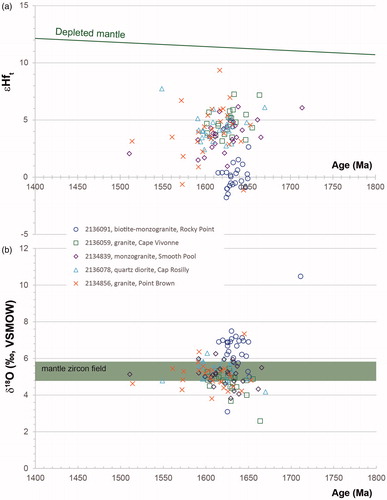
The remaining analyses from the four other samples have a reasonably consistent Hf isotopic composition, with 176Hf/177Hf ratios that vary from 0.281766 (sample 2134856, analysis 12) to 0.282017 (sample 2136078, analysis 6.2; ; Table S2). This range corresponds to εHf(t) values between –0.6 and +7.7, with corresponding two-stage (crustal) model ages between ca 2312 to ca 1784 Ma. When each sample is considered individually, these samples all have εHf(t) values that cluster at around +4; weighted mean εHf(t) values for individual samples range from +3.83 to +4.88 ().
SHRIMP zircon O isotopes
The range of individual δ18O values for all St Peter Suite magmatic zircon has a maximum of 7.49 (sample 2136091, analysis 11) and a minimum of 2.58 (sample 2136059, analysis –3; see Table S2). This range in δ18O values straddles mantle δ18O compositions of 5.3 ± 0.17 (Valley, Kinny, Schulze, & Spicuzza, Citation1998; Valley et al., Citation2005), being both significantly depleted and also enriched in 18O (). A mean δ18O value of 6.3 can be calculated from zircon of sample 2136091 (Rocky Point, monzogranite), which is higher than mantle composition and higher than other samples from the St Peter Suite on average (Table S2). The inherited zircon from sample 2136091 is significantly enriched in 18O than other zircons in this and other samples, with a mean δ18O value of 10.47. The remaining samples have mean δ18O values between 4.7 and 5.3 (; Table S2). The data for the St Peter Suite thus contain a component of zircon that has mantle-like or slightly enriched in 18O than average mantle δ18O signature. We note that some individual zircons have compositions that are depleted in 18O than average mantle.
Whole-rock geochemistry
SiO2 values for the St Peter Suite range from 40.5 to 79.2 wt% and shows broadly bimodal distribution; a peak at 51 wt% and a larger grouping that spans 68–76 wt% (). Fe2O3, TiO2, MgO and CaO show consistent trends, generally decreasing with increasing SiO2. Conversely, K2O increases with SiO2 and most felsic samples plot in the high-K series. Al2O3 increases towards intermediate compositions and then decreases as the composition becomes increasingly felsic, a result of increasing quartz content of the felsic rocks.
Figure 9. Summary of whole-rock geochemical data from the St Peter Suite. Red data points are data from this study. Grey data points are compiled from previous studies (Chalmers, Citation2009; GSSA unpublished data; Dove, Citation1997; Ferris, Citation2001; Knight, Citation1997; Swain et al., Citation2008). Data tabulated in Table S3. (a) Histogram of SiO2 (wt%) for all data. (b) Fe2O3 vs SiO2. (c) TiO2 vs SiO2. (d) MgO vs SiO2. (e) CaO vs SiO2. (f) K2O vs SiO2. (g) Al2O3 vs SiO2.
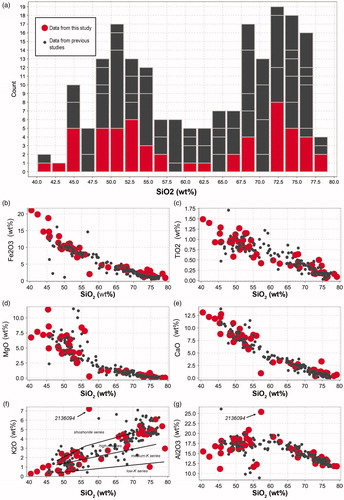
When our new geochemical data are classified according to the physical magmatic setting, that is, as either a felsic pluton, a multiphase felsic pluton, a magma transfer zone or a mafic magma chamber, two relatively simple trends emerge (). The first is that the two end-member physical magma systems, the felsic pluton and the mafic magma chamber lie at opposite ends of the SiO2 compositional spectrum. In comparison, the multiphase plutons and the zones of magma transfer have SiO2 compositions that are intermediate between the high and low SiO2 rock types. This suggests the intermediate compositions present in the St Peter Suite may be derived from mixing of mafic and felsic magmas.
Figure 10. Whole-rock major element data from this study classified according to physical magma setting. (a) Histogram of SiO2 (wt%) for samples from felsic plutons. (b) Histogram of SiO2 for samples from multiphase plutons. (c) Histogram of SiO2 for samples from magma transfer zones. (d) Histogram of SiO2 for samples from mafic magma chambers, particularly the exposures at Cap Rosilly. (e) Alkali–iron–magnesium (AFM) diagram. Tholeiitic–calc-alkaline line after Irvine and Baragar (Citation1971).
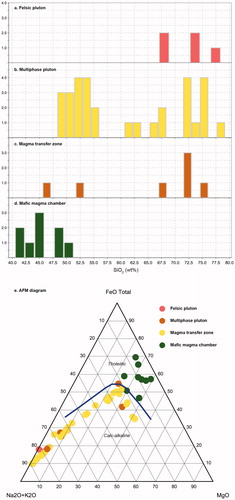
The felsic (here >63 wt% SiO2) St Peter Suite samples from the felsic plutons, multiphase plutons and zones of magma transfer are ferroan to moderately magnesian, alkali-calcic to calc-alkalic () and I type, and are moderately peraluminous (Aluminium Saturation Index mostly >1.05). Felsic samples have trace-element compositions with broad patterns such as Nb, Ta, Ti depletions relative to other trace elements when normalised to Primordial Mantle composition (Taylor & McLennan, Citation1985). Sr is variable, with some samples being quite depleted, while Y is broadly enriched relative to relative to Primordial Mantle (). Overall the incompatible element trend is broadly enriched compared with average continental crust (). Felsic units are generally enriched in light rare earth elements (REEs) over heavy REEs, have negative Eu anomalies, and the bulk of the samples having similar REE values to average continental crust with slightly elevated light REE compositions (). Samples 2136061 and 2134840 have anomalously depleted heavy REE compositions (). These two samples are late-stage felsic dykes that intrude the norite and pyroxenite bodies at Cap Rosilly. Their composition may reflect fractionation of late-stage silica-rich magmas from the likely cumulate pyroxenite bodies at this locality.
Figure 11. Summary of whole-rock geochemical data from the St Peter Suite for samples >63 wt% SiO2. Red circles are data from this study, and grey circles are data from previous studies. (a) Magnesium number. (b) Modified alkali-lime index. Calculations of magnesium number and alkali-lime index are after Frost et al. (Citation2001). (c) Primordial mantle normalised trace-element diagram for samples from this study only. (d) Chondrite normalised REE diagram for samples from this study only. Normalisation values after Taylor and McLennan (Citation1985). Global subducted sediment source (GLOSS) after Plank and Langmuir (Citation1998). Average crust after Rudnick and Gao (Citation2003).
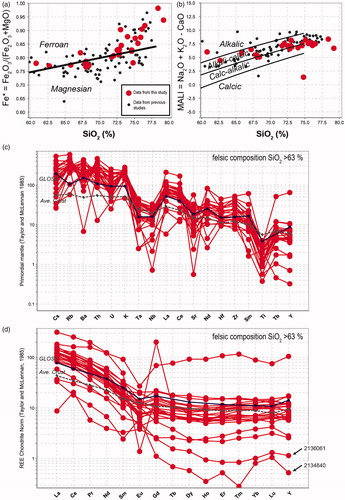
Samples from the mafic magma chamber are predominantly Fe-rich tholeiites in composition (). Mafic St Peter Suite samples have variable large-ion lithophile element (e.g. Cs, Rb, Ba) compositions. Sr is generally more enriched than E-MORB reference values (Klein, Citation2004). Th and Nb compositions are generally depleted with respect to U and broadly mirrors co-existing depletion in Nb within individual samples (). Compared with Chondrite values (Taylor & McLennan, Citation1985), the samples are enriched in light REEs and are mostly greater than E-MORB reference values. These samples have a moderate positive Eu* anomaly, low abundance of heavy REEs that approaches depleted mantle, a relatively concave heavy REE profile (), and plot above the mean depleted mantle values on an Nb/Yb vs Th/Yb plot ().
Figure 12. Summary of whole-rock geochemical data from the St Peter Suite for samples <63 wt% SiO2. Primitive Mantle normalised trace and REE variation diagrams. Normalisation values after Taylor and McLennan (Citation1985). Data plotted are only those collected in this study. Data tabulated in Table S3. Depleted mantle model after Salters and Stracke (Citation2004). Enriched-mid-ocean ridge basalt (E-MORB) after Klein (Citation2004). Global subducted sediment source (GLOSS) after Plank and Langmuir (Citation1998). Average crust after Rudnick and Gao (Citation2003).
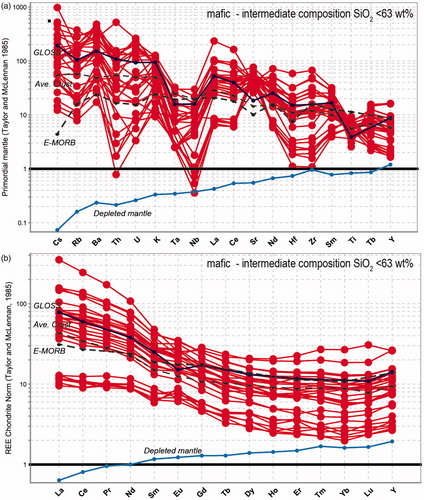
Figure 13. Incompatible trace-element variation diagram after (Pearce, Citation2008) with data from the mafic St Peter Suite from this study. Abbreviations: DM, depleted mantle; E-MORB, enriched mid-ocean ridge basalt; MORB, mid-ocean ridge basalt; OIB, oceanic island basalt.
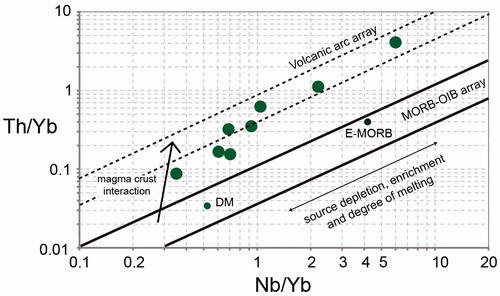
Whole-rock Sm–Nd and Sr isotope data
St Peter Suite rocks with <55 wt% SiO2 show a range of εNd(1620 Ma) values, from a maximum of +2.2 and a minimum of –1.1, with a mean of +0.2 (; Tables 1 and S4). Compositions that are intermediate to felsic also yield a range of εNd(1620 Ma) values, from a maximum of +3.7 and a minimum of –3.7, with a mean of –0.2 ( and S4). Although there is a subtle but general trend towards lower εNd(1620 Ma) values with higher SiO2, this trend is weak; it appears that most St Peter Suite rocks have similar εNd(1620 Ma) values that vary about chondritic uniform reservoir (CHUR). In addition, there appears to be no correlation between εNd(1620 Ma) values and age based on our new SHRIMP data ().
Figure 14. Nd and Sr radiogenic isotope characteristics of the St Peter Suite plotted against measured whole-rock SiO2 for each sample. (a) εNd(1620 Ma) values for whole-rock samples of the St Peter Suite. Red circles are data from this study, and grey circles are data from previous studies (Chalmers, Citation2009; Dove, Citation1997; Knight, Citation1997; Swain et al., Citation2008; Symington et al., Citation2014). Data tabulated in Table S4. (b) Depleted mantle model age (TDM). (c) Initial 87Sr/86Sr ratios (Sri) for St Peter Suite samples. Calculation using initial age of 1620 Ma.
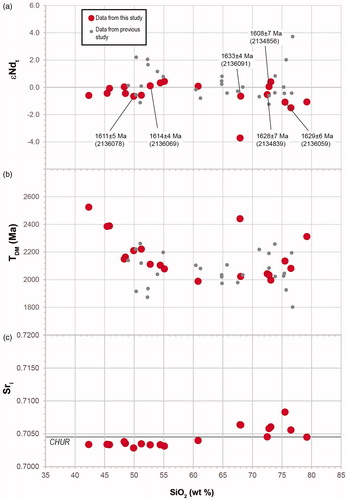
Depleted mantle model ages (TDM) for the felsic rocks of the St Peter Suite range from ca 2530 to ca 1990 Ma, with a near continuum between these two end-members (; Table S4). Intriguingly, data from this study shows a trend of highest TDM values for the samples with the lowest SiO2, decreasing such that the more intermediate compositions have the lowest TDM, and then reversing this trend so that the high SiO2 phases, in general, have older TDM (). We note that sample 2136091 has an εNd(1620 Ma) value of +0.1 and a TDM value of 2030 Ma, yet in εHf(t) space yields an overall more evolved composition. Although this particular sample may hint at some degree of decoupling between Nd and Hf isotopic evolution, the overall isotopic dataset is internally consistent.
87Sr/86Sr isotope data obtained in this study and initial 87Sr/86Sr ratios (Sri) calculated based on an initial age of 1620 Ma have similar values across the range of SiO2, such that mafic rocks have Sri values slightly below or on the CHUR and even the most siliceous samples have values only slightly above this (; and S4). Some component of the higher Sri values may indicate Sr mobility in the granitic units; however, the degree to which secondary processes have affected the isotopic composition appears minimal.
Discussion
St Peter Suite: timing of emplacement
The SHRIMP geochronology from this study could be interpreted to indicate two broad phases of magmatism at ca 1633 Ma and ca 1608 Ma (). However, an analysis of variance (ANOVA) test to compare the mean ages of the six samples shows that the mean ages are significantly heterogeneous; F5,56 = 12.3, p < 0.001 (; where homogeneity is indicated if p ≥ 0.05; McDonald, Citation2014). These results suggest that magmatism was likely continuous but episodic over a ca 35 million-year period. This is also evident when considering the entire U–Pb zircon dataset available for the St Peter Suite (). Therefore, we interpret the geochronological data to suggest that St Peter Suite magmatism occurred over an interval of about 25 million years, between ca 1633 and ca 1608 Ma. We note that taking into consideration the upper and lower confidence bounds of the oldest and youngest weighted mean age from this SHRIMP study (1637 ± 4 and 1608 ± 7 Ma) gives a total permissible age range for the St Peter Suite from an upper limit of 1637 Ma and a younger limit of 1601 Ma. Higher precision dating may show that there are discrete pulses of magmatism; however, we cannot be certain of this, given the precision of available geochronology.
Figure 15. Summary of zircon U–Pb geochronology obtained in this study and previous studies of the St Peter Suite. (a) Probability density distribution of SHRIMP zircon magmatic ages obtained in this study. (b) Mean ages of the six samples analysed in this study, as calculated for ANOVA. The error bars show the 95% confidence interval around the mean. Horizontal bars below the graph link samples that are not significantly different in age (Games–Howell pairwise comparisons). (c) Weighted mean 207Pb/206Pb magmatic crystallisation ages for the St Peter Suite in order of increasing age. Blue bars indicate samples from this study. Grey bars represent data from previous SHRIMP studies (Fanning et al., Citation2007; Jagodzinski & Reid, Citation2016; Jagodzinski et al., Citation2007), laser ablation-inductively coupled plasma mass spectrometry (Reid & Dutch, Citation2012; Symington et al., Citation2014) and Kober Pb–Pb evaporation technique (Knight, Citation1997).
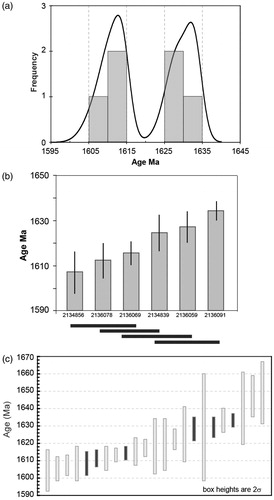
Further, we note that laser ablation-inductively coupled plasma mass spectrometry (LA-ICPMS) dating of a tonalitic gneiss from the Rocky Point locality produced an age of 1647 ± 12 Ma for a tonalitic gneiss (Symington et al., Citation2014). This age overlaps in uncertainty with the oldest age obtained in this study, being 1633 ± 4 Ma from a biotite--monzogranite also from the same Rocky Point locality. The two studies are consistent in suggesting that the Rocky Point locality contains the oldest portions of the St Peter Suite; however, as the data were derived from two different analytical techniques (SHRIMP and LA-ICPMS) some uncertainty remains about exactly how old the oldest portion of the St Peter Suite could be.
Of the younger ages obtained from this study, the quartz diorite lithologies from the Cap Rosilly and Point James localities are 1611 ± 5 Ma and 1614 ± 4 Ma, respectively. These samples derive from a mafic magma chamber at Cap Rosilly and a portion of a multiphase pluton from Point James. The youngest age derives from a granite from the Point Brown locality, part of a multiphase pluton (sample 2134856; 1608 ± 7 Ma). The data therefore suggest that the mafic magma chamber from the Cap Rosilly locality was broadly coeval with the multiphase plutons of the Point James and Point Brown localities. It is possible, therefore, that the later magmatism within the St Peter Suite involved a larger degree of mafic input into the crustal levels now exposed. In contrast, earliest magmatism appears to be dominated by more felsic compositions.
Structural features of the St Peter Suite
Structural observations indicate that the St Peter Suite was emplaced into a tectonic regime that included compressive stress. The absence of consistent sense of shear and oblique overprinting relations suggests that this compressional deformation was not due to simple shear. Rather, the presence of generally parallel structural elements, kinematic indicators, folding and boudinage/pinch and swell features suggests that pure shear was the dominant process (Pawley et al., Citation2016). The predominant north-striking orientation of structural elements within the St Peter Suite suggests that deformation was controlled by broadly east–west-directed shortening (in current orientation).
An example of syn-magmatic pure shear deformation is documented from Cretaceous batholiths of the Sierra Nevada (Tomek et al., Citation2017). Pure shear was dominant in this example where the deforming plutons were emplaced at relatively shallow levels and therefore into cooler, stronger host rocks. By analogy with the Cretaceous examples of the Sierra Nevada, it is possible that St Peter Suite zones of magma transfer, which accommodated pure shear, were formed within a similarly cool crustal level. Although the boundaries of the St Peter Suite magma transfer zones are poorly defined, the available geochronology, surface exposure and potential field data support the idea that these zones occurred within St Peter Suite-aged plutons that were emplaced earlier, rather than older country rocks. Although dependent upon size and depth of emplacement, in general the cooling of upper crustal plutonic bodies can occur over a time-scale of less than one million years (e.g. Caricchi, Annen, Rust, & Blundy, Citation2012). Given the magmatic history of the St Peter Suite spans ca 1633–1608 Ma, there is likely enough time to account for emplacement and cooling of earlier plutonic bodies that could then form the cool, host rocks for zones of magma transfer and attendant pure shear. By way of contrast, simple shear and pervasive deformation is the dominant process late in the formation of the Sierra Nevada batholiths when the volume of magma increased such that sheet-like intrusions and associated crystallising plutons become the weakest portion of the crust, thereby becoming wholesale zones of shear to accommodate the syn-magmatic strain (Tomek et al., Citation2017). This style of deformation is more akin to that described by Symington et al. (Citation2014) for the more gneissic, and likely more deeply emplaced portions of the St Peter Suite exposed at the Rocky Point locality.
While the overall strike of structural elements of the St Peter Suite is north–south, there are some locations at which these elements are NNW-striking (i.e. The Granites and the region from Rocky Point to Cap Rosilly; ). There are at least two interpretations for the origin of the different orientations. It may be a primary feature representing a perturbation of strike within an overall north–south-trending corridor of deformation, for example if the foliation in these regions were equivalent to broad-scale shear bands, analogous to the smaller, outcrop examples seen throughout the rocks of the St Peter Suite. Alternatively, the different strike direction may be a result of later modification, perhaps due to rotation of the St Peter Suite-aged fabrics into or within younger shear zones. In either case, the overall structural geometry of deformation during emplacement of the St Peter Suite is consistent with east–west-directed shortening in current coordinates.
The east–west-directed shortening derived from observations along coastal exposures of the St Peter Suite are consistent with structural mapping of deformed St Peter Suite bodies from inland outcrops reported by Stewart and Betts (Citation2010). In that study, a St Peter Suite pluton underwent east- to northeast-directed ductile thrusting, followed by cataclasis and alteration, with pseudotachylite development overprinting the earlier ductile fabrics. The deformation appears to have evolved from broadly east–west compression through the ductile and into the brittle deformation, most probably recording the progressive exhumation of the St Peter Suite (Stewart & Betts, Citation2010). Importantly, nearby Hiltaba Suite granites record only a younger phase of extensional deformation, thereby bracketing the deformation recorded in the St Peter Suite to being prior to Hiltaba Suite emplacement (Stewart & Betts, Citation2010). This suggests that the compressional deformation affected the St Peter Suite across a wide area of the suite’s current distribution.
Constraints on contemporaneous mantle composition from mafic rocks
Our new geochemical data from the mafic magma chamber and from mafic dykes within multiphase plutons suggest the mafic rocks are tholeiitic in origin. The mafic rocks have relatively low heavy REE profiles and mostly positive Eu* anomalies, which suggest a Eu-rich mineral such as plagioclase was not stable in the source region. However, indicators of garnet stability such as high values for (Gd/Yb)N are absent, with this ratio of middle to heavy REEs mostly around 1.0. This is interpreted to indicate the presence of either amphibole or pyroxene in the source region. Furthermore, isotopic data support a moderately juvenile mantle source with εNd1620 Ma values clustering around 0. Zircon δ18O values for the quartz diorite fall predominantly in the mantle field, or slightly below (δ18O range 6.3–4.1, mean 5.3).
Trace-element enrichment in mafic rocks can occur via contamination of continental crust during magma ascent or as a result of magma chamber processes such as assimilation of wall rocks. Trace-element enrichment can also be a feature of the primary mantle source region, such that a depleted mantle source can be modified by metasomatic processes such as through subduction, or via repeated partial melting. In the case of the mafic rocks of the St Peter Suite, we suggest that trace-element enrichments are more likely to be a feature of the mantle source. To support this interpretation, we emphasise the mantle-like zircon δ18O values for the quartz diorite within the mafic magma chamber. If crustal contamination has played a role in the formation of these trace-element enrichments, it has not made a significant impact on the zircon δ18O budget. Furthermore, the most primitive mafic rocks analysed in this study have relatively high Cr and Ni contents yet their corresponding Nd isotopic values are not especially juvenile. For example, a pyroxenite sample, from the mafic magma chamber at Cap Rosily (2136086) with 310 ppm Cr and 90 ppm Ni has εNd(1620 Ma) of –0.4 and a TDM around 2400 Ma. A sample of gabbro from Point Brown in a multiphase pluton has 410 ppm Cr and 96 ppm Ni and εNd(1620 Ma) of +0.4 and a TDM around 2000 Ma (sample 2134857; Supplementary papers, Appendix 3). In addition, we note that some of the individual zircon δ18O values actually fall below the reference mantle field, which could point towards interaction between the source region and high-temperature waters (e.g. Valley et al., Citation1998). While the magnitude of the δ18O depletions below mantle values is not great, it is worth noting that low δ18O values (<5.3) in kimberlite of the Kaapvaal Craton are interpreted to derive from melting of previously hydrated and therefore potentially subduction metasomatised eclogite (Valley et al., Citation1998). Based on these data, it is possible to interpret the St Peter Suite as being derived from an enriched mantle source that may have interacted with high-temperature fluids. The enrichment of the lithospheric mantle source in high-field-strength elements and REEs may have occurred prior to formation of the St Peter Suite given that the TDM model ages for mafic rocks are in the order of 2000 Ma or older.
Fractional crystallisation and assimilation revealed by felsic units
As mentioned, SiO2 values for the St Peter Suite are broadly bimodal, although intermediate compositions are present. Felsic end-member compositions are found in the felsic magma chamber bodies, as well as in the magma transfer zones and the composite plutons. These units have major- and trace-element characteristics of typical continental crust, including enrichment in high-field-strength elements and LILEs; depletions in Ti, Nb and Ta, modest enrichment in light REEs along with modest Sr depletion, modest Y enrichment, and predominantly negative Eu* anomalies indicating plagioclase was stable in the source region, and/or there was significant fractionation of feldspar during crystallisation.
Isotopically, however, the felsic bodies of the St Peter Suite are very similar to their mafic counterparts with εNd1620 Ma values between –3.7 and +0.4, εHf(t) values that cluster between 0 and +5, and mean δ18O values between 4.7 and 6.5, which therefore generally lie within or near to mantle values. That there is little variation in εNd(1620 Ma) and Sri values with SiO2, implies that the source was well mixed prior to fractionation.
In addition to fractional crystallisation, physical magma textures indicate that at least some of the intermediate compositions are a result of magma mingling and mixing (cf. Collins, Richards, Healy, & Ellison, Citation2000). This is particularly evident in the samples from multiphase plutons and magma transfer zones, which contain more intermediate compositions than samples from felsic magma chambers. The mixing of the mafic and felsic compositions appears to have affected the mafic rocks such that they are less Fe-rich, and therefore more calc-alkaline, and have enrichment in LILEs as well as increased abundance of light REEs. Therefore, while some of the intermediate compositions may derive from primary fractionation processes from deeper within the magma plumbing system, the evidence for some component of magma mingling and mixing is compelling.
Although a well-mixed source is evident in the majority of the data, there is a notable outlier in this pattern: sample, 2136091, a tonalite from a multiphase pluton. This sample contains an inherited Paleoproterozoic zircon (ca 1710 Ma), has the most elevated zircon δ18O values and the oldest mean model age in the zircon Lu–Hf system (). More broadly, the εNd values of the St Peter Suite suggest pre-existing crust that was assimilated crust into the St Peter Suite must have been isotopically juvenile. Indeed, by comparison with Archean and Paleoproterozoic magmatic rocks from the Gawler Craton, the St Peter Suite is on average more juvenile, indicating the St Peter Suite has not interacted with significant Archean crust (). Rather, as evidenced by the inherited zircon in sample 2136091, any crust that has interacted with and been assimilated into the St Peter Suite is most likely be Paleoproterozoic in age. In summary, the felsic portion of the St Peter Suite was derived from both fractional crystallisation from a mafic source coupled with some degree of assimilation of crustal material of probable Paleoproterozoic age.
Figure 16. εNdt vs time plot for samples of the St Peter Suite and representative samples across the Gawler Craton. St Peter Suite data from this study, Chalmers (Citation2009), Dove (Citation1997), Knight (Citation1997), Swain et al. (Citation2008), and Symington et al. (Citation2014). Gawler Craton data taken from various sources, chiefly a compilation in Reid and Hand (Citation2012). References therein. Also shown is a curve representing the mean Nd isotopic evolution of Gawler Craton Neoarchean crust. Felsic compositions for the purposes of this diagram are taken to be those with >63 wt% SiO2.
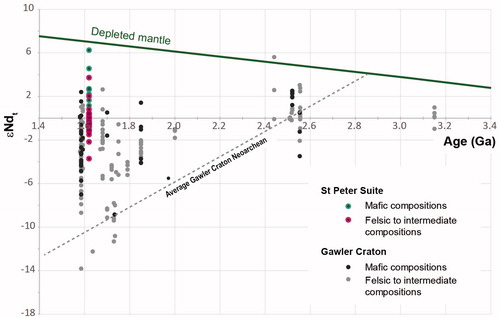
We note also that although the moderately peraluminous nature of the St Peter Suite felsic rocks may indicate some component of crustal assimilation, there is also the potential that partial melting of a mafic lower crust or upper mantle source region could produce such peraluminous granitoids (Chappell, Bryant, & Wyborn, Citation2012). In such a scenario, melting of amphibole and biotite yields pyroxene, with the excess aluminium being incorporated in to the felsic liquid leading to peraluminous composition. However, in this scenario we would expect to see a positive correlation between SiO2 content and Aluminium Saturation Index, which is not the case for the St Peter Suite. Therefore, we prefer a model of fractionation from a mantle source rock with some minor crustal assimilation in the formation of the felsic rocks of the St Peter Suite.
Key geochemical and structural features of the St Peter Suite
The trace-element composition of any magmatic suite is a function of the source magma type and crystallisation history of the melt. The tectonic environment in which the magma was generated is of secondary influence on the composition and in this respect can be non-unique (e.g. Arculus, Citation1987; Condie, Citation2015; Frost et al., Citation2001). Fractional crystallisation with a component of assimilation, however, is not a diagnostic tool for inferring tectonic setting of magmatic rock systems. While it may be tempting to ascribe features like the trace-element depletions such as Nb and Ta as indicative of a subduction zone setting, variations in depth of crystallisation (pressure–temperature), water content and time-scales of magmatic process all impact upon the geochemical signature. The resulting debates between petrologists that advocate subduction or non-subduction setting for granite suites such as in Proterozoic granites of Australia (Wyborn et al., Citation1992), the Phanerozoic of the Lachlan Fold Belt (e.g. Keay, Collins, & McCulloch, Citation1997) or indeed in the tectonics of Archean cratons such as the Superior (e.g. Bedard, Citation2006; Keller & Schoene, Citation2018; Martin, Smithies, Rapp, Moyen, & Champion, Citation2005) are therefore debates that to some extent revolve around non-unique geochemical discriminators.
With these caveats in mind, we summarise the key geochemical and structural features of the St Peter Suite that must be accounted for in either a subduction or within-plate model for the tectonic setting. First, any model must account for the presence of tholeiitic mafic rocks probably derived from an enriched mantle source and felsic rocks derived by fractional crystallisation from that mafic source. The geochemical data from the St Peter Suite imply that the tholeiitic magmas were derived from modest volume melting of metasomatised continental or possibly oceanic lithosphere that was enriched in LILEs and light REEs, rather than the depleted mantle asthenosphere. As for the timing of this possible enrichment of the mantle lithosphere, it may have occurred prior to formation of the St Peter Suite. The Paleoproterozoic model ages for the most primitive mafic rock samples suggest some Paleoproterozoic Nd was present in the mantle lithosphere. Contemporaneous subduction is a possible cause of this enrichment; however, it could equally have formed during a previous metasomatic event. The timing of enrichment of the mantle source region is poorly constrained, and it may be that the St Peter Suite is derived from melting of a pre-existing mafic, continental lithospheric source.
Secondly, any model must account for the presence of only minor, slightly older crust in the vicinity of the magma system. The only inherited zircon documented from the St Peter Suite is Paleoproterozoic in age, and that isotopic model ages for the St Peter Suite are predominantly also Paleoproterozoic, between ca 2500 and 1800 Ma. There does not appear to be a requirement for a significant Archean component in the St Peter Suite. This is an interesting result as in the currently exposed crustal levels of the Gawler Craton, the St Peter Suite occurs adjacent to, or at least within close proximity to Neoarchean rock packages (Mulgathing and Sleaford complexes; ). Seismic and magnetotelluric interpretations of the bulk lithospheric architecture of the Gawler Craton suggest that a resistive and by inference depleted and Archean lower crust should occur in the region beneath the St Peter Suite (Thiel & Heinson, Citation2010, Citation2013), yet the geochemical and isotopic composition suggests limited interaction between Archean rocks and the juvenile St Peter Suite. Rather, pre-existing rocks that did interact with the new St Peter Suite magmas are likely to have been Paleoproterozoic in age and relatively juvenile in isotopic composition. The Tunkillia Suite is a possible example of pre-existing moderately juvenile crust located in the central Gawler Craton (Payne et al., Citation2010) that could have interacted with the magmas of the St Peter Suite (as discussed by Skirrow et al., Citation2018).
Third, any model must account for the observation that the St Peter Suite magmatic system was associated with compressional deformation as recorded in the magma transfer zones and in the magmatic and solid-state foliations within multiphase plutons. This has been documented previously as solid-state, steep-dipping mica-defined foliations within the Nuyts Vocalnics (Flint & Rankin, Citation1991; Rankin & Flint, Citation1989), in the multiphase folding of magmatic and solid-state foliations in the western coastal exposures of the St Peter Suite (Symington et al., Citation2014), and in the eastern, inland exposures of the St Peter Suite (Stewart & Betts, Citation2010). The syn-magmatic nature of the compressional fabrics requires a tectonic model that involves deformation of the St Peter Suite between ca 1635 and 1608 Ma.
St Peter Suite petrogenesis: tectonic models
The model of Swain et al. (Citation2008) considers the St Peter Suite to have formed as a result of subduction in an intra-oceanic setting outboard of the Gawler Craton (). This model can account for some aspects of the key datasets, principally the formation of tholeiitic magmatism and the apparent enrichment of the lithospheric mantle source. This model also explains the apparently minimal interaction between the Archean portions of the Gawler Craton by invoking arc–continent collision after formation of the St Peter Suite (Swain et al. Citation2008). While there is evidence for compressional deformation during formation of the St Peter Suite, the large-scale translation of the entire St Peter Suite magmatic system after formation necessitates movement along major regional detachments. The majority of the shear zones in the Gawler Craton that have been dated, however, appear to have ages that are either older, or younger than the inferred timing of amalgamation of the St Peter Suite with the Gawler Craton in the model of Swain et al. (Citation2008). For example, monazite in high-temperature metamorphic rocks in the Fowler Domain to the west of the St Peter Suite yields ages of either ca 1690 Ma or ca 1580 Ma (Howard, Hand, Barovich, Payne, & Belousova, Citation2011), while fabric-forming biotite in the same Fowler Domain shear zones yields 40Ar/39Ar ages of ca 1450 Ma (Fraser & Lyons, Citation2006). This is not consistent with the model of Swain et al. (Citation2008).
Figure 17. Summary of tectonic models for possible evolution of the St Peter Suite. (a) Model of Swain et al. (Citation2008), showing the formation of St Peter Suite outboard of the Gawler Craton on south-dipping subduction zone. This is followed by the amalgamation of the St Peter Suite arc and the Gawler Craton lithosphere during convergence at ca 1608 Ma. (b) Model of the St Peter Suite proposed by Skirrow et al. (Citation2018), which places the St Peter Suite in a continental arc setting. (c) Purely extensional model for the formation of the St Peter Suite, similar to model proposed by Etheridge et al. (Citation1987).
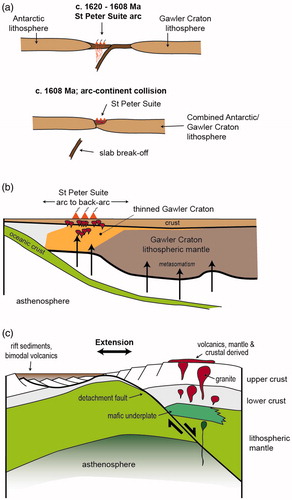
A second subduction-related model for the tectonic setting of the St Peter Suite has been proposed by Skirrow et al. (Citation2018), which builds on a number of previous similar interpretations (e.g. Betts et al., Citation2009, Citation2011). This interpretation argues that the St Peter Suite represents a continental magmatic arc that was built on thinned pre-existing Gawler Craton lithosphere (). This model is able to account for the presence of continental tholeiites as being the product of decompressional melting of lithospheric mantle beneath continental crust owing to upper plate extension in board of a subduction zone. A continental magmatic arc model is also able to account for variable assimilation of Proterozoic crust into the felsic components of the St Peter Suite, as the arc is built upon pre-existing continental crust. In addition, placing the St Peter Suite in a continental arc setting can account for the presence of compressional deformation. Changes in convergence rates or subduction dip angle could provide mechanisms for the development of deformation during magmatism. We note that while Phanerozoic arc systems can evolve from compression to extension with time, deformation associated with the arc systems is not necessarily localised within the plutonic rocks themselves, rather deformation in the fore arc, back arc, or even in the continental interior as a response to far-field stress is common (Ducea et al., Citation2015). Therefore, in the Gawler Craton, we may expect to see a tectonic response to the inferred subduction system of the St Peter Suite occurring in the regions around the St Peter Suite during the early Mesoproterozoic.
An alternative model for the St Peter Suite would be one in which extension of the continental lithospheric mantle resulted in melting of pre-existing, fractionated mantle-derived mafic rocks in the lithospheric mantle and lower crust (). This type of model is similar to those presented by Etheridge, Rutland, and Wyborn (Citation1987) for example. Such a model is able to account for the presence of tholeiitic magmas of the St Peter Suite as a result of decompression melting of the continental lithospheric mantle. This type of model predicts minimal interaction between St Peter Suite magmas and pre-existing Archean crust, and consequently a broadly bimodal SiO2 composition. This type of purely extensional model requires a high degree of extension to have occurred such that Archean crust was virtually absent in the region in which the St Peter Suite formed. However, such an extensional model cannot account for the presence of syn-magmatic compressional structures that are observed in the St Peter Suite. In a purely extensional model, a switch in tectonic style towards the end of a magmatic event would be required to form these structures. In the St Peter Suite, syn-magmatic magma transfer zones, including those present at the Smooth Pool locality, were forming at ca 1628 Ma as indicated by the age of foliated granite sheets such as sample 2134839. This is relatively early in the magmatic evolution of the St Peter Suite. Therefore, a purely extensional model akin to that advocated by Etheridge et al. (Citation1987), in which magmatism is driven by the elevation of the continental geotherm by removal of overlying crust, cannot account for syn-magmatic compressional structures, nor for the apparently minor interaction between these magmas and the Archean crust of the Gawler Craton.
Of these models, the one that is most able to satisfy the main physical and geochemical evidence preserved within the St Peter Suite is some type of continental magmatic arc. Placing the St Peter Suite in a subduction-related setting has profound implications for the subsequent geological evolution of the Gawler Craton, in particular for the formation of the metallogenically significant Hiltaba Suite and Gawler Range Volcanics between ca 1595 and 1575 Ma. The possible links between the St Peter Suite and these early Mesoproterozoic magmatic systems are further explored by Skirrow et al. (Citation2018).
While a continental magmatic arc model may account for many of the features of the St Peter Suite, it is vital to recognise that any assessment of paleo-tectonic setting of magmatic suites such as the St Peter Suite requires integration of a range of datasets including the structural geology and rock associations in the prior and subsequent geological evolution of the region in order to be holistic (see Condie, Citation2015). As noted by Hand et al. (Citation2007), the Gawler Craton is a relatively small crustal fragment, when compared with the length scale of modern subduction systems. As a result, the tectonic drivers for the different magmatic suites are likely to have operated at a scale beyond what is preserved within the craton itself. The data presented in this study provide constraints on the petrogenesis and structural geology of the St Peter Suite that can be integrated with future work on tectonic systems across the Paleoproterozoic to Mesoproterozoic transition within the Australian continent and correlative regions in Laurentia (e.g. Pehrsson, Eglington, Evans, Huston, & Reddy, Citation2015). The more sophisticated models that will emerge from future work should aim to recognise the large-scale patterns in geochemical and rock associations in rock packages that include time equivalent units of the St Peter Suite, including for example the ca 1620 Ma Moondini Super Suite of the Madura Province (Spaggiari & Smithies, Citation2015), as well as those that pre- and post-date this suite. A holistic view of the tectonic setting of magmatism during the Proterozoic requires such a broad analysis. Although beyond the scope of the current study, our new data from the St Peter Suite will contribute to such an analysis.
Conclusions
The St Peter Suite is a complex magmatic system characterised by interaction between co-magmatic mafic, intermediate and felsic magmas. Mingling between mafic and felsic magmas occurred in zones of magma transfer and in low strain zones, in which mafic dykes have interacted with a semi-solid crystal mush of a felsic magma chamber. Syn-magmatic deformation resulted from east–west compression in current coordinates. Geochronological data suggest the St Peter Suite formed over a period of ca 25 Myr. Geochemically, the St Peter Suite is bimodal; however, there are intermediate compositions albeit subordinate in volume, which likely formed via mixing of mafic and felsic end-members as is preserved in magma transfer zones and in multiphase plutonic bodies.
The felsic St Peter Suite is moderately magnesian, alkali-calcic to calc-alkalic and peraluminous, with depletions in trace elements such as Ti, Ta, Nb, enrichment in LILEs and mantle-like zircon δ18O and whole-rock εNd(1620 Ma) values, consistent with being co-magmatic with the associated mafic rocks and being derived from fractionation from a mantle source. Mafic units of the St Peter Suite are enriched in high-field-strength elements and have generally positive Eu* and relatively low heavy REEs, which suggests melting of an enriched lithospheric mantle source.
Interpretation of the tectonic setting of Australian Proterozoic magmatic suites is made difficult by the non-uniqueness of most geochemical indicators. Previous interpretations generally either emphasise modern-style lateral accretion of linear belts, or continental ribbons (Betts & Giles, 2001; Betts et al., Citation2016; Skirrow et al., Citation2018) or vertical processes such as changes in the depth of melting of magmatic suites to explain the variation in chemical composition (Wyborn et al., Citation1987, Citation1992). While the St Peter Suite contains enrichments and depletions in elements that are consistent with but not unique to subduction settings, the presence of syn-magmatic compressional deformation is a key feature of the suite that remains difficult to reconcile with a purely extensional tectonic setting of formation. A continental magmatic arc built on thinned, Proterozoic Gawler Craton crust is a model that best explains the main features of the St Peter Suite. Nevertheless, further work to investigate the structural and chemical composition of the St Peter Suite and related rocks of southern Australia is required as the tectonic drivers of the St Peter Suite likely operated at a length scale beyond what is currently preserved within the Gawler Craton. Future work that links the St Peter Suite to similarly aged magmatic suites and synchronous deformation or metamorphic events across Australia and correlative regions of Laurentia will help to further illuminate the tectonic setting of this time period.
A. J. Reid et al AJES 67 Table S1 SHRIMP Zircon U-Pb isotope data
Download MS Excel (31.6 KB)A. J. Reid et al AJES 67 Table S2 Zircon Hf and O isotope data
Download MS Excel (219.5 KB)A. J. Reid et al AJES 67 Table S3 Whole rock geochemical data
Download MS Excel (134.9 KB)A. J. Reid et al AJES 67 Table S4 Whole rock Nd Sr isotope data
Download MS Excel (46.2 KB)A. J. Reid et al. AJES 6791) Supp Papers
Download PDF (149.6 KB)Acknowledgements
U–Pb analyses were conducted using the SHRIMP IIe ion microprobe at Geoscience Australia, as part of an NGA agreement between Geoscience Australia and the Geological Survey of South Australia. Technical support from staff at the Geoscience Australia Geochronology Labs is acknowledged. David Bruce is thanked for conducting the Sm–Nd analyses at the University of Adelaide. We acknowledge discussions with Lesley Wyborn on granite geochemistry and with Chris Kirkland on oxygen isotope systematics. David Champion provided very helpful comments on a previous version of the manuscript. Reviews by Eloise Beyer and Peter Betts significantly improved the paper and are gratefully acknowledged. Published with permission of Director, Geological Survey of South Australia.
Disclosure statement
No potential conflict of interest was reported by the authors.
Additional information
Funding
References
- Aitken, A. R. A., Betts, P. G., Young, D. A., Blankenship, D. D., Roberts, J. L., & Siegert, M. J. (2016). The Australo-Antarctic Columbia to Gondwana transition. Gondwana Research, 29(1), 136–152. doi:10.1016/j.gr.2014.10.019
- Allen, S. R., McPhie, J., Ferris, G., & Simpson, C. (2008). Evolution and architecture of a large felsic igneous province in western Laurentia: The 1.6 Ga Gawler Range Volcanics, South Australia. Journal of Volcanology and Geothermal Research, 172(1-2), 132–147. doi:10.1016/j.jvolgeores.2005.09.027
- Arculus, R. J. (1987). The significance of source versus process in the tectonic controls of magma genesis. Journal of Volcanology and Geothermal Research, 32(1–3), 1–12. doi:10.1016/0377-0273(87)90033-3
- Bedard, J. H. (2006). A catalytic delamination-driven model for coupled genesis of Archaean crust and sub-continental lithospheric mantle. Geochimica et Cosmochimica Acta, 70, 1188–1214. doi:10.1016/j.gca.2005.11.008
- Betts, P. G., & Giles, D, Anonymous (2001). Proterozoic Australia and plate tectonics. In Geological Society of America, 2001 annual meeting. Boulder, CO: Geological Society of America (GSA).
- Betts, P. G., & Giles, D. (2006). The 1800–1100 Ma tectonic evolution of Australia. Precambrian Research, 144(1–2), 92–125. doi:10.1016/j.precamres.2005.11.006
- Betts, P. G., Armit, R. J., Stewart, J., Aitken, A. R. A., Ailleres, L., Donchak, P., … Giles, D. (2016). Australia and Nuna. Geological Society, London, Special Publications, 424(1), 47–81. doi:10.1144/SP424.2
- Betts, P. G., Giles, D., & Aitken, A. (2011). Palaeoproterozoic accretion processes of Australia and comparisons with Laurentia. International Geology Review, 53(11-12), 1357–1376. doi:10.1080/00206814.2010.527646
- Betts, P. G., Giles, D., Foden, J., Schaefer, B. F., Mark, G., Pankhurst, M. J., … Hills, Q. (2009). Mesoproterozoic plume-modified orogenesis in eastern Precambrian Australia. Tectonics, 28(3), n/a–n/a. doi:10.1029/2008TC002325
- Budd, A. R., Wyborn, L. A. I., & Bastrakova, I. V. (2001). The metallogenic potential of Australian Proterozoic granites. Canberra ACT: Geoscience Australia Record 2001/12, 152 p.
- Caricchi, L., Annen, C. J., Rust, A. C., & Blundy, J. D. (2012). Insights into the mechanisms and timescales of pluton assembly from deformation patterns of mafic enclaves. Journal of Geophysical Research, 117(B11206). doi:10.1029/2012JB009325
- Cawood, P. A., & Korsch, R. J. (2008). Assembling Australia: Proterozoic building of a continent. Precambrian Research, 166(1-4), 1–38. doi:10.1016/j.precamres.2008.08.006
- Chalmers, N. C. (2009). Geodynamic evolution of the St Peter Suite, Gawler Craton, South Australia: stratigraphic, geochemical and isotopic investigation. School of Geosciences, Monash University, Clayton Vic, unpublished MSc thesis.
- Chappell, B. W., Bryant, C. J., & Wyborn, D. (2012). Peraluminous I-type granites. Lithos, 153, 142–153. doi:10.1016/j.lithos.2012.07.008
- Collins, W. J., Richards, S. R., Healy, B. E., & Ellison, P. I. (2000). Origin of heterogeneous mafic enclaves by two-stage hybridisation in magma conduits (dykes) below and in granitic magma chambers. Earth and Environmental Science Transactions of the Royal Society of Edinburgh, 91(1-2), 27–45. doi:10.1017/S0263593300007276
- Condie, K. (2015). Changing tectonic settings through time: Indiscriminate use of geochemical discriminant diagrams. Precambrian Research, 266, 587–591. doi:10.1016/j.precamres.2015.05.004
- Cooper, J. A., Mortimer, G. E., Rosier, C. M., & Uppill, R. K. (1985). Gawler Range magmatism; further isotopic age data. Australian Journal of Earth Sciences, 32(2), 115–123. doi:10.1080/08120098508729318
- Daly, S. J., & Fanning, C. M. (1993). Archaean. In J. F. Drexel, W. V. Preiss, & A. J. Parker (Eds.), The geology of South Australia; volume 1, the precambrian (pp. 32–49). Adelaide, SA: Geological Survey of South Australia. Bulletin 54.
- Daly, S. J., Fanning, C. M., & Fairclough, M. C. (1998). Tectonic evolution and exploration potential of the Gawler Craton, South Australia. AGSO Journal of Australian Geology & Geophysics, 17, 145–168.
- Dove, M. B. (1997). The geology, petrology, geochemistry and isotope geology of the eastern St Peter Suite, western Gawler Craton, South Australia (Unpublished BSc Hons thesis). University of Adelaide, Adelaide SA.
- Ducea, M. N., Saleeby, J. B., & Bergantz, G. (2015). The architecture, chemistry, and evolution of continental magmatic arcs. Annual Review of Earth and Planetary Sciences, 43(1), 299–331. doi:10.1146/annurev-earth-060614-105049
- Etheridge, M. A., Rutland, R. W. R., & Wyborn, L. A. I. (1987). Orogenesis and tectonic process in the early to middle Proterozoic of northern Australia. In A. Kroner (Ed.), Proterozoic lithospheric evolution (pp. 131–147). Boulder, CO: American Geophysical Union.
- Fanning, C. M., Reid, A. J., & Teale, G. (2007). A geochronological framework for the Gawler Craton, South Australia. Adelaide, SA: South Australia Geological Survey, Bulletin 55.
- Ferris, G. M. (2001). The geology and geochemistry of granitoids in the CHILDARA region, western Gawler Craton, South Australia: Implications for the Proterozoic tectonic history of the western Gawler Craton and the development of lode-style gold mineralisation at Tunkillia (Unpublished MSc thesis). University of Tasmania, Hobart Tas.
- Ferris, G. M., Schwarz, M. P., & Heithersay, P. (2002). The geological framework, distribution and controls of Fe-oxide and related alteration, and Cu–Au mineralisation in the Gawler Craton, South Australia. Part I: geological and tectonic framework. In T. M. Porter (Ed.), Hydrothermal iron oxide copper–gold and related deposits: A global perspective (Vol. 2, pp. 9–31). Adelaide, SA: PGC Publishing.
- Flint, R. B., & Rankin, L. R. (1991). The St. Francis Granite of the southwestern Gawler Craton. Quarterly Geological Notes – Geological Survey of South Australia, 119, 17–23. Retrieved from https://sarigbasis.pir.sa.gov.au/WebtopEw/ws/samref/sarig1/image/DDD/QGN119.pdf
- Flint, R. B., Blissett, A. H., Conor, C. H. H., Cowley, W. M., Cross, K. C., Creaser, R. A., … Parker, A. J. (1993). Mesoproterozoic. In J. F. Drexel, W. V. Preiss, & A. J. Parker (Eds.), The geology of South Australia; Volume 1, The Precambrian (pp. 106–169). Adelaide, SA: Geological Survey of South Australia, Bulletin 54.
- Flint, R. B., Rankin, L. R., & Fanning, C. M. (1990). Definition; the Palaeoproterozoic St. Peter Suite of the western Gawler Craton. Quarterly Geological Notes – Geological Survey of South Australia, 114, 2–8. Retrieved from https://sarigbasis.pir.sa.gov.au/WebtopEw/ws/samref/sarig1/image/DDD/QGN114.pdf
- Fraser, G., & Lyons, P. (2006). Timing of Mesoproterozoic tectonic activity in the northwestern Gawler Craton constrained by 40Ar/39Ar geochronology. Precambrian Research, 151(3-4), 160–184. doi:10.1016/j.precamres.2006.08.007
- Fraser, G., McAvaney, S., Neumann, N., Szpunar, M., & Reid, A. (2010). Discovery of early Mesoarchean crust in the eastern Gawler Craton, South Australia. Precambrian Research, 179(1-4), 1–21. doi:10.1016/j.precamres.2010.02.008
- Fraser, G., Reid, A., & Stern, R. (2012). Timing of deformation and exhumation across the Karari Shear Zone, north-western Gawler Craton, South Australia. Australian Journal of Earth Sciences, 59(4), 547–570. doi:10.1080/08120099.2012.678586
- Frost, B. R., Barnes, C. G., Collins, W. C., Arculus, R. J., Ellis, D. J., & Frost, C. D. (2001). A geochemical classification for granititc rocks. Journal of Petrology, 42(11), 2033–2048. doi:10.1093/petrology/11.2033
- Giles, D., Betts, P. G., & Lister, G. S. (2004). 1.8–1.5-Ga links between the North and South Australian Cratons and the Early–Middle Proterozoic configuration of Australia. Tectonophysics, 380(1–2), 27–41. doi:10.1016/j.tecto.2003.11.010
- Hand, M., Reid, A., & Jagodzinski, E. (2007). Tectonic framework and evolution of the Gawler Craton, South Australia. Economic Geology, 102(8), 1377–1395. doi:10.2113/gsecongeo.102.8.1377
- Hou, B., Keeling, J., Reid, A., Fairclough, M., Warland, I., Belousova, E., … Hocking, R. (2011). Heavy mineral sands in the Eucla Basin, Southern Australia: Deposition and province-scale prospectivity. Economic Geology, 106(4), 687–712. doi:10.2113/econgeo.106.4.687
- Howard, K. E., Hand, M., Barovich, K. M., Payne, J. L., & Belousova, E. A. (2011). U–Pb, Lu–Hf and Sm–Nd isotopic constraints on provenance and depositional timing of metasedimentary rocks in the western Gawler Craton: Implications for Proterozoic reconstruction models. Precambrian Research, 184(1-4), 43–62. doi:10.1016/j.precamres.2010.10.002
- Ickert, R. B., Hiess, J., Williams, I. S., Holden, P., Ireland, T. R., Lanc, P., … Clement, S. W. (2008). Determining high precision, in situ, oxygen isotope ratios with a SHRIMP II: Analyses of MPI-DING silicate-glass reference materials and zircon from contrasting granites. Chemical Geology, 257(1–2), 114–128. doi:10.1016/j.chemgeo.2008.08.024
- Irvine, T. N., & Baragar, W. R. A. (1971). A guide to the chemical classification of the common volcanic rocks. Canadian Journal of Earth Sciences, 8(5), 523–548. doi:10.1139/e71-055
- Jagodzinski, E. A., Reid, A. J., Chalmers, N. C., Swain, G., Frew, R. A., & Foudoulis, C. (2007). Compilation of SHRIMP U–Pb geochronological data for the Gawler Craton, South Australia, 2007. Adelaide, SA: South Australia Department of Primary Industries and Resources, Report Book, 2007/21. Retrieved from https://sarigbasis.pir.sa.gov.au/WebtopEw/ws/samref/sarig1/image/DDD/RB200700021.pdf
- Jagodzinski, E., & Reid, A. J. (2016). U–Pb geochronological data from drill holes Nundroo 3 DDH and Nundroo 2 DDH, Fowler Domain, western Gawler Craton. Adelaide, SA: Department for State Development, Report Book 2016/00010. Retrieved from https://sarigbasis.pir.sa.gov.au/WebtopEw/ws/samref/sarig1/image/DDD/RB201600010.pdf
- Keay, S., Collins, W. J., & McCulloch, M. T. (1997). A three-component Sr–Nd isotopic mixing model for granitoid genesis, Lachlan fold belt, eastern Australia. Geology, 25(4), 307–310. doi:10.1130/0091-7613(1997)025<0307:atcsni>2.3.co;2
- Keller, B., & Schoene, B. (2018). Plate tectonics and continental basaltic geochemistry throughout Earth history. Earth and Planetary Science Letters, 481, 290–304. doi:10.1016/j.epsl.2017.10.031
- Klein, E. M. (2004). Geochemistry of the igneous oceanic crust. In H. D. Holland & K. K. Turekian (Eds.), Treatise on Geochemistry (Vol. 3, pp. 433–463). Amsterdam: Elsevier.
- Knight, J. M. (1997). Petrogenesis of the western St Peter Suite, western Gawler Craton, South Australia – a petrological, geochemical and isotopic investigation (BSc Hons thesis (unpublished)). The University of Adelaide, Adelaide, SA.
- Korsch, R. J., Kositcin, N., & Champion, D. C. (2011). Australian island arcs through time: Geodynamic implications for the Archean and Proterozoic. Gondwana Research, 19(3), 716–734. doi:10.1016/j.gr.2010.11.018
- Martin, H., Smithies, R. H., Rapp, R., Moyen, J.-F., & Champion, D. (2005). An overview of adakite, tonalite-trondhjemite-granodiorite (TTG), and sanukitoid: relationships and some implications for crustal evolution. Lithos, 79(1–2), 1–24. doi:10.1016/j.lithos.2004.04.048
- McDonald, J. H. (2014). Handbook of biological statistics (3rd ed.). Baltimore, MA: Sparky House Publishing. http://www.biostathandbook.com/onewayanova.html.
- Motta, J. G., Betts, P. G., de Souza Filho, C. R., Thiel, S., Curtis, S., & Armit, R. J. (2019). Proxies for basement structure and its implications for Mesoproterozoic metallogenic provinces in the Gawler Craton. Journal of Geophysical Research: Solid Earth, 124, 3088–3104. doi:10.1029/2018jb016829
- Munizaga, F., Maksaev, V., Fanning, C. M., Giglio, S., Yaxley, G., & Tassinari, C. C. G. (2008). Late Paleozoic–Early Triassic magmatism on the western margin of Gondwana: Collahuasi area, Northern Chile. Gondwana Research, 13(3), 407–427. doi:10.1016/j.gr.2007.12.005
- Myers, J. S., Shaw, R. D., & Tyler, I. M. (1996). Tectonic evolution of Proterozoic Australia. Tectonics, 15(6), 1431–1446. doi:10.1029/96TC02356
- Pawley, M. J., Reid, A. J., & Dutch, R. (2016). Magmatic systems of the St Peter Suite, western Gawler Craton: insights from reconnaissance mapping. MESA Journal, 81, 4–12.
- Payne, J. L., Ferris, G., Barovich, K. M., & Hand, M. (2010). Pitfalls of classifying ancient magmatic suites with tectonic discrimination diagrams: An example from the Paleoproterozoic Tunkillia Suite, southern Australia. Precambrian Research, 177(3-4), 227–240. doi:10.1016/j.precamres.2009.12.005
- Pearce, J. A. (2008). Geochemical fingerprinting of oceanic basalts with applications to ophiolite classification and the search for Archean oceanic crust. Lithos, 100(1-4), 14–48. doi:10.1016/j.lithos.2007.06.016
- Pehrsson, S. J., Eglington, B. M., Evans, D. A. D., Huston, D., & Reddy, S. M. (2015). Metallogeny and its link to orogenic style during the Nuna supercontinent cycle. In Z. X. Li, D. A. D. Evans, & J. B. Murphy (Eds.), Supercontinent Cycles through Earth History (pp. 83–94). London UK: Geological Society. doi:10.1144/sp424.5
- Plank, T., & Langmuir, C. H. (1998). The chemical composition of subducting sediment and its consequences for the crust and mantle. Chemical Geology, 145(3-4), 325–394. doi:10.1594/PANGAEA.706145
- Rankin, L. R., & Flint, R. B. (1989). Geology of St. Peter and Goat Island (Nuyts Archipelago) and Cape Beaufort. Adelaide SA: South Australia Department of Mines and Energy Report Book 89/84. Retrieved from https://sarigbasis.pir.sa.gov.au/WebtopEw/ws/samref/sarig1/image/DDD/RB8900084.pdf
- Rankin, L. R., Flint, R. B., & Fanning, C. M. (1990). Palaeoproterozoic Nuyts Volcanics of the western Gawler Craton. Adelaide, SA: South Australia Department of Primary Industries and Resources. Report Book, 90/00060. Retrieved from https://sarigbasis.pir.sa.gov.au/WebtopEw/ws/samref/sarig1/image/DDD/RB9000060.pdf
- Reid, A. J. (2017). Geology and metallogeny of the Gawler Craton. In G. N. Phillips (Ed.), Australian ore deposits (pp. 589–594). Melbourne, Vic: The Australasian Institute of Mining and Metallogeny.
- Reid, A. J., & Dutch, R. (2012). Reconnaissance LA-ICPMS zircon U–Pb geochronology of crystalline basement outcrops on the FOWLER 1:250000 mapsheet. Adelaide, SA: Department for Manufacturing, Innovation, Trade, Resources and Energy, South Australia, Report Book 2012/00013. Retrieved from https://sarigbasis.pir.sa.gov.au/WebtopEw/ws/samref/sarig1/image/DDD/RB201200013.pdf
- Reid, A. J., & Hand, M. (2012). Mesoarchean to Mesoproterozoic evolution of the southern Gawler Craton, South Australia. Episodes, 35, 216–225.
- Reid, A. J., & Payne, J. L. (2017). Magmatic zircon Lu–Hf isotopic record of juvenile addition and crustal reworking in the Gawler Craton, Australia. Lithos, 292–293 (Supplement C), 294–306. doi:10.1016/j.lithos.2017.08.010
- Reid, A. J., Jagodzinski, E. A., Fraser, G. L., & Pawley, M. J. (2014). SHRIMP U–Pb zircon age constraints on the tectonics of the Neoarchean to early Paleoproterozoic transition within the Mulgathing Complex, Gawler Craton, South Australia. Precambrian Research, 250(0), 27–49. doi:10.1016/j.precamres.2014.05.013
- Reid, A. J., Pawley, M. J., Jagodzinski, E., & Dutch, R. A. (2016). Magmatic processes of the St Peter Suite, Gawler Craton: New U–Pb geochronological data and field observations. Adelaide SA: Department of State Development. Report Book 2016/00012. Retrieved from https://sarigbasis.pir.sa.gov.au/WebtopEw/ws/samref/sarig1/image/DDD/RB201600012.pdf
- Rudnick, R. L., & Gao, S. (2003). Composition of the continental crust. In R. L. Rudnick (Ed.), The crust (Vol. Treatise on Geochemistry, vol. 3, pp. 1–64): Oxford, UK: Elsevier/Pergamon,
- Salters, V., & Stracke, A. (2004). Composition of the depleted mantle. Geochemistry, Geophysics, Geosystems, 5(5), Q05004. doi:10.1029/2003GC000597
- Şengör, A. M. C., Altıner, D., Cin, A., Ustaömer, T., & Hsü, K. J. (1988). Origin and assembly of the Tethyside orogenic collage at the expense of Gondwana Land. Geological Society, London, Special Publications, 37(1), 119–181. doi:10.1144/GSL.SP.1988.037.01.09
- Skirrow, R. G., Bastrakov, E. N., Barovich, K., Fraser, G. L., Creaser, R. A., Fanning, C. M., … Davidson, G. J. (2007). Timing of iron oxide Cu–Au–(U) hydrothermal activity and Nd isotope constraints on metal sources in the Gawler Craton, South Australia. Economic Geology, 102(8), 1441–1470. doi:10.2113/gsecongeo.102.8.1441
- Skirrow, R. G., Wielen, S. E., Champion, D. C., Czarnota, K., & Thiel, S. (2018). Lithospheric architecture and mantle metasomatism linked to Iron Oxide Cu–Au Ore formation: Multidisciplinary evidence from the Olympic Dam region, South Australia. Geochemistry, Geophysics, Geosystems, 19, 2673–2705. doi:10.1029/2018GC007561
- Spaggiari, C., & Smithies, R. H. (2015). Eucla basement stratigraphic drilling results release workshop: extended abstracts. Perth, WA: Geological Survey of Western Australia, Record 2015/10.
- Stewart, J. R., & Betts, P. G. (2010). Late Paleo–Mesoproterozoic plate margin deformation in the southern Gawler Craton: Insights from structural and aeromagnetic analysis. Precambrian Research, 177(1–2), 55–72. doi:10.1016/j.precamres.2009.11.004
- Swain, G., Barovich, K., Hand, M., Ferris, G., & Schwarz, M. (2008). Petrogenesis of the St Peter Suite, southern Australia: arc magmatism and Proterozoic crustal growth of the South Australian Craton. Precambrian Research, 166(1-4), 283–296. doi:10.1016/j.precamres.2007.07.028
- Symington, N. J., Weinberg, R. F., Hasalová, P., Wolfram, L. C., Raveggi, M., & Armstrong, R. A. (2014). Multiple intrusions and remelting-remobilization events in a magmatic arc: The St. Peter Suite, South Australia. GSA Bulletin, 126(9–10), 1200–1218. doi:10.1130/B30975.1
- Taylor, S. R., & McLennan, S. M. (1985). The continental crust: Its composition and evolution. Oxford UK: Blackwell Scientific Publications.
- Thiel, S., & Heinson, G. (2010). Crustal imaging of a mobile belt using magnetotellurics: An example of the Fowler Domain in South Australia. Journal of Geophysical Research: Solid Earth, 115(B6), B06102. doi:10.1029/2009JB006698
- Thiel, S., & Heinson, G. (2013). Electrical conductors in Archean mantle—Result of plume interaction? Geophysical Research Letters, 40(12), 2947–2952. doi:10.1002/grl.50486
- Tomek, F., Žák, J., Verner, K., Holub, F. V., Sláma, J., Paterson, S. R., & Memeti, V. (2017). Mineral fabrics in high-level intrusions recording crustal strain and volcano–tectonic interactions: the Shellenbarger pluton, Sierra Nevada, California. Journal of the Geological Society, 174(2), 193–208. doi:10.1144/jgs2015-151
- Valley, J. W., Kinny, P. D., Schulze, D. J., & Spicuzza, M. J. (1998). Zircon megacrysts from kimberlite: Oxygen isotope variability among mantle melts. Contributions to Mineralogy and Petrology, 133(1-2), 1–11. doi:10.1007/s004100050432
- Valley, J. W., Lackey, J. S., Cavosie, A. J., Clechenko, C. C., Spicuzza, M. J., Basei, M. A. S., … Wei, C. S. (2005). 4.4 billion years of crustal maturation: oxygen isotope ratios of magmatic zircon. Contributions to Mineralogy and Petrology, 150(6), 561–580. doi:10.1007/s00410-005-0025-8
- Wade, B. P., Hand, M., & Barovich, K. M. (2005). Nd isotopic and geochemical constraints on provenance of sedimentary rocks in the eastern Officer Basin, Australia: Implications for the duration of the intracratonic Petermann Orogeny. Journal of the Geological Society, 162(3), 513–530. doi:10.1144/0016-764904-001
- Wade, C. E., Payne, J. L., Barovich, K. M., & Reid, A. J. (2019). Heterogeneity of the sub-continental lithospheric mantle and ‘non-juvenile’ mantle additions to a Proterozoic silicic large igneous province. Lithos, 340–341, 87–107. doi:10.1016/j.lithos.2019.05.005
- Wyborn, L. A. I., Page, R. W., & Parker, A. J. (1987). Geochemical and geochronological signatures in Australian Proterozoic igneous rocks. In T. C. Pharaoh, R. D. Beckinsale, & D. T. Rickard (Eds.), Geochemistry and mineralization of proterozoic volcanic suites (Vol. 33, pp. 377–394). London, UK: Geological Society of London. doi:10.1144/GSL.SP.1987.033.01.26
- Wyborn, L. A. I., Wyborn, D., Warren, R. G., & Drummond, B. J. (1992). Proterozoic granite types in Australia: implications for lower crustal composition, structure and evolution. Transactions for the Royal Society of Edinburgh: Earth Sciences, 83(1–2), 201–209. doi:10.1017/S0263593300007896
